Abstract
Recent advancements in satellite Earth observation (EO) technology have significantly improved the accuracy and density of data available for monitoring rivers and streams, as well as for diagnosing errors in hydraulic models. Laser and radar altimetry missions, such as ICESat-2 (Ice, Cloud, and Land Elevation Satellite-2) and SWOT (Surface Water and Ocean Topography), offer high-resolution measurements of land and water surface elevation (WSE), covering entire river reaches and providing high-resolution WSE profiles along the river chainage, which can be directly compared to hydraulic model results. In this study, we implemented a workflow to assess the accuracy of simulated WSE and evaluate the performance of hydraulic models in the Chao Phraya (CPY) River, using WSE data from ICESat-2 and SWOT. The evaluation of ICESat-2, SWOT, and simulated WSE from the model, compared to in situ data, resulted in root mean square error (RMSE) values of 0.34 m, 0.35 m, and 0.37 m, respectively. Despite this, both ICESat-2 and SWOT data proved effective for error detection and performance evaluation along the CPY river in point, profile, and spatial map comparisons, with overall RMSE values of 0.36 m and 0.33 m, respectively, when compared with simulated WSE. This paper demonstrates that ICESat-2 and SWOT are valuable tools for diagnosing errors and improving hydraulic model performance, providing critical insights for river monitoring and model validation.
1. Introduction
Flood forecasting and risk assessment models are indispensable tools for mitigating the adverse impacts of floods, especially as climate change intensifies extreme weather events worldwide. These models have been implemented across diverse regions, including the Ourthe River in Belgium [1], the Illinois River in the United States [2], regions in Poland [3] and Rwanda [4], and the Meuse and Rhine rivers in the UK [5]. Despite their success, model performance is highly dependent on accurate and spatially extensive data for calibration, validation, and error analysis. This is particularly challenging in regions with limited in situ monitoring networks, where sparse data can limit the ability of models to represent the spatial variability of river systems effectively.
In Thailand, a national flood forecasting system covering approximately 70% of the country was developed through collaboration between the Hydro-Informatics Institute (HII) and DHI A/S [6]. This system simulates major river basins, including the complex Chao Phraya River basin, which presents unique challenges due to its extensive irrigation network, reservoirs, limited monitoring stations, and numerous control structures. These complexities continue to make the development of the Chao Phraya (CPY) flood forecasting system a challenging and ongoing effort. Additionally, the scarcity of in situ water surface elevation (WSE) gauges along the rivers significantly impacts the accuracy of hydraulic models. These models rely on historical data from in situ gauges, which are collected at specific points or locations, to perform calibration, validation, evaluation, and error analysis (e.g., Yellow River delta [7], Mae Chaem catchment [8]. However, the sparse distribution of these gauges limits their ability to capture the spatial variability of water surface elevations along the entire river profile. This constraint hampers the accuracy and reliability of hydraulic models, as they require comprehensive and continuous data to simulate river dynamics effectively. While calibrated hydraulic models may show good performance at or close to the in-situ stations used for calibration, performance in reaches located far away from calibration points is unknown and large errors and biases are expected.
Satellite Earth observation (EO) data provide a transformative solution for overcoming these challenges, offering opportunities to improve model calibration, validation, and evaluation, even in data-scarce regions and in river reaches located far away from in situ calibration points. Previous studies have demonstrated the utility of EO missions such as RADARSAT-2 [8], ERS-2 and ENVISAT [9,10], CrycoSat-2 [11], and single- and multi-mission satellite altimetry [12]. However, most of those earlier missions provided WSE time series at a few discrete points along the river, the so-called virtual stations. The Ice, Cloud, and Land Elevation Satellite-2 (ICESat-2) is a satellite equipped with a laser altimeter, capable of measuring ice sheet and glacier elevation change, sea ice freeboard, land elevation, and water elevation [13]. It provides opportunities for monitoring and validating water surface elevation (WSE) and hydraulic models, particularly in remote and hard-to-access regions. Applications include validating ICESat-2 ATL13 WSE with near real-time gauges in India [14], measuring water levels over lakes and reservoirs in China [15], estimating water levels in the Upper Yangtze River [16], and monitoring water level changes using a new denoising algorithm combined with Landsat data [17]. Other studies have utilized ICESat-2 for hydrodynamic model calibration [18], generating global reach-scale water surface slope datasets [19], monitoring inland water level changes in Turkey’s lakes and dams [20], and improving river WSE accuracy in Australia [21]. Similarly, Surface Water and Ocean Topography (SWOT), launched in 2022 and equipped with a nadir altimeter and a bistatic Ka-band Radar Interferometer (KaRIn), can measure WSE and inland water [22]. Prior to the availability of real data from SWOT in 2023, previous studies using synthetic SWOT data were conducted for supporting, monitoring, and validating WSE and inundation areas. These studies include measuring WSE and slope and estimating river discharge in the UK [23], assimilating SWOT data for operational reservoir management in the Upper Niger River Basin [24], reducing noise to enhance SWOT WSE profiles in the Sacramento River [25], and achieving unprecedented precision in measuring ocean and continental water surface elevations in the Seine Estuary [26]. Both ICESat-2 and SWOT provide dense WSE datasets along entire river reaches, which map the WSE profile along the river at high accuracy and spatial resolution over many river kilometers. Although EO data provides WSE, the raw EO WSE needs preprocessing and filtering to remove noise and spikes before it can be compared to simulated WSE from hydraulic models and in situ data. As shown in previous studies, integrating advanced satellite EO datasets into hydraulic models enhances their capability to accurately simulate and predict water levels, particularly in data-scarce regions.
This study focuses on the integration of ICESat-2 and SWOT datasets into the CPY flood forecasting system to enhance its performance. The paper begins by outlining the study’s background and its practical applications in the introduction. The materials section describes the study area, the hydraulic model, and the datasets used. The method section explains the setup of the hydraulic model, the process of estimating WSE from both ICESat-2 and SWOT datasets, and the comparison methodology. Specifically, it evaluates the hydraulic model performance by comparing simulated WSE profiles with observations from three key sources: ICESat-2 ATL03, SWOT, and in situ gauges. This comparison is carried out using statistical methods, including bias (mean error, ME), mean absolute error (MAE), mean squared error (MSE), and root mean squared error (RMSE), through point-wise, profile, and spatial analyses. The workflow incorporates advanced data preprocessing techniques to filter out noise and spikes, followed by point-wise and spatial statistical comparisons, and error diagnostics to quantify model accuracy. The results section presents model calibration outcomes and evaluates WSE estimates from satellite datasets compared with in situ observations and simulated WSE. The discussion evaluates the accuracy of the satellite datasets, assesses model performance, and suggests potential improvements, while the conclusion summarizes the key findings.
The results demonstrate that integrating satellite Earth observation (EO) data into the CPY hydraulic model provides valuable insights that would not have been achievable with in situ data alone. By diagnosing spatial discrepancies between observed and simulated WSE, these datasets reveal areas where model improvements are needed, thus enhancing the model’s ability to accurately simulate flood dynamics. These findings highlight the critical role of state-of-the-art EO data in overcoming challenges in flood forecasting, particularly in regions with limited in situ monitoring capabilities. Furthermore, this study establishes a benchmark for incorporating satellite datasets into operational flood forecasting systems globally, offering a strategic framework for improving water resource management in data-scarce environments.
2. Materials
2.1. Study Area
The study area is situated in the central part of Thailand, within the Chao Phraya (CPY) river basin, as depicted in Figure 1A. The CPY river basin spans approximately 20,523 square kilometers, receiving an average annual rainfall of 1340 mm and experiencing an average annual pan evaporation rate of 1410 mm. The CPY river is a major river in Thailand originating in the Nakhon Sawan province in the northern part of Thailand, where the Ping, Wang, Yom, and Nan rivers merge into the CPY river, as illustrated in Figure 1B. The CPY river’s discharge ranges from approximately 150 to 4600 m³/s. The CPY river joins the Sakae Krang River from the right bank in the upstream CPY. The primary structure on the CPY river is the CPY dam, established in 1957 and managed by the Royal Irrigation Department (RID) of Thailand. This dam regulates the CPY river discharge and supplies irrigation water to the left and right banks of the river. The CPY dam releases around 400 m³/s, with a recorded maximum discharge of 3721 m³/s. Branching off from the CPY dam’s right bank are the Tha-Chin River and Noi River, while the Chainat–Pasak Canal diverts discharge from the left bank upstream of the CPY dam. The Tha Chin River flows to the Gulf of Thailand, whereas the Noi River rejoins the CPY river at Ayutthaya province, where the CPY river also meets the Pa Sak River. The Pa Sak River has two main structures: the Pa Sak Cholasit Dam and the Rama VI Dam, both controlled by RID before merging with the CPY river, as displayed in Figure 1B.
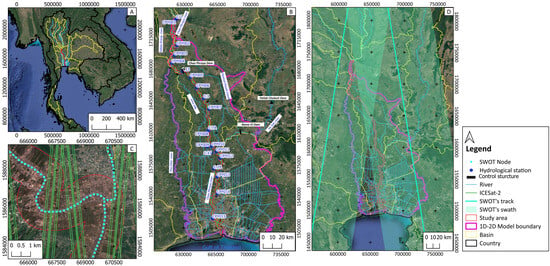
Figure 1.
(A) The study area located in Thailand; (B) overview of the study area including (1) 1D-2D model boundary, (2) in situ stations, (3) control structures, and 4) ICESat-2 overpasses in the study area; (C) ICESat-2 beam pairs overpasses and SWOT nodes in the study area; and (D) overall SWOT orbit overpasses in the study. All panels are based on the Universal Transverse Mercator (UTM) Zone 47 North coordinate system. © Google Earth.
The study area experiences a tropical climate, characterized by three distinct seasons: rainy, winter, and summer. The rainy season, influenced by the southwest monsoon, extends from mid-May to mid-October. During the summer season, from November to April, climatic conditions are influenced by the northeast monsoon from China and tropical storms from the South China Sea. The main causes of flooding in the CPY basin are extreme precipitation, river overflows, and sea-level rise originating from the CPY river. This study focuses on the CPY river, which flows from upstream through Bangkok and ultimately reaches the Gulf of Thailand. The river spans a total length of approximately 380 km, with its width ranging from 50 to 1200 m, as depicted in Figure 1B.
2.2. Hydraulic Model
In this study, we employed the hydraulic model from the decision support system (DSS) for flood forecasting and water management for Chao Phraya (CPY) river basin, Thailand [27]. The system, updated in 2016 through collaboration with HII and DHI A/S, remains operational, providing ongoing support to the Thai government for decision-making.
The hydraulic model within the DSS for flood forecasting and water management in the CPY river basin comprises two hydrodynamic models: a one-dimensional (1D) hydrodynamic model and a coupled one-dimensional and two-dimensional (1D-2D) hydrodynamic model, implemented in MIKE11 and MIKE FLOOD software version 2020 developed by DHI A/S, respectively. The 1D hydrodynamic model simulates flow in the main rivers of the upper and lower CPY basin, while the coupled 1D-2D hydrodynamic model focuses on the lower CPY basin, extending from the river’s upstream to the Gulf of Thailand [28].
The coupled 1D-2D hydrodynamic model (MIKE FLOOD), which includes the 1D hydrodynamic model (MIKE11), simulates unsteady flow in river networks by solving the Saint-Venant equations with an implicit finite difference solver [29]. The 1D hydrodynamic model effectively simulates river and canal flows under both steady (constant) and unsteady (time-varying) conditions. It provides a detailed analysis of flooding by assessing water levels and identifying inundation extents. Furthermore, it integrates seamlessly with rainfall-runoff data and hydrological models to predict flooding across various regions. The model excels in simulating the operation of hydraulic structures, such as sluice gates and dams, and accurately captures tidal dynamics in riverine and coastal systems. The 2D hydrodynamic model (MIKE21) simulates overland flow using 2D shallow water equations [30], based on the digital elevation model (DEM), to assess flood depth and its propagation. MIKE FLOOD links the two models (1D and 2D hydrodynamic model) through lateral connections, employing a cell-to-cell approach and the weir equation to calculate overflow [31].
Boundary conditions for the coupled 1D-2D model include upstream discharge data from the C.2 station and release flows from the Pa Sak Cholasit Dam, both managed by the RID. The downstream boundary condition incorporates sea level data provided by the Hydrographic Department of the Royal Thai Navy, as depicted in Figure 1B. The model was calibrated using water level observations presented by [28].
2.3. ICESat-2 Satellite Laser Altimetry
Ice, Cloud, and Land Elevation Satellite-2 (ICESat-2) is a laser altimetry satellite launched by the National Aeronautics and Space Administration (NASA) on September 15, 2018. ICESat-2 measures the elevation of ice sheets, glaciers, sea ice, and various other land features with a 91-day repeat cycle with a subcycle of 30 days [32]. ICESat-2 is equipped with the Advanced Topographic Laser Altimeter System (ATLAS), with a staggering rate of 10,000 laser pulses per second using laser light of 532 nm [13]. The pulse rate enables the satellite to capture a measurement every 70 cm along the ground track. Laser pulse from ATLAS divides into six beams, organized into three left/right pairs. Left/right spots within each pair are approximately 90 m and the distance between each pair is 3.3 km, as illustrated in Figure 1C.
The National Snow and Ice Data Center (NSIDC) portal has developed 21 products that incorporate photon travel times and locations determined using the built-in GPS from the ICESat-2 satellite, as detailed on the website: https://nsidc.org/data/icesat-2/products (accessed on 18 April 2024). Two different products are used in this study, namely ATL03 and ATL13, as described in more detail in Table 1. The ICESat-2 data were obtained from the NSIDC website via their data access tool (https://nsidc.org/data/data-access-tool (accessed on 18 April 2024).

Table 1.
Satellite products.
- ATL03: ATLAS/ICESat-2 L2A Global Geolocated Photon Data
The ATL03 data product from ICESat-2 is a vital intermediary between lower- and higher-level products, which provides time, latitude, longitude, and height information for each downlinked photon, which acts as a comprehensive source of photon data for subsequent analyses, enabling the generation of surface-specific products such as land ice height and sea ice freeboard [33]. ATL03 also includes surface masks and photon event classifications and applies geophysical corrections to improve accuracy. Furthermore, it provides necessary spacecraft and instrument information for higher-level data products. Its crucial role in streamlining data processing and serving as a consistent data source supports further scientific research.
- ATL13: ATLAS/ICESat-2 L3A Inland Water Surface Height
The ATL13 data product is derived from the ATL03 product. The ATL13 product contains along-track surface water height for inland water bodies, including statistics on surface water height (mean, standard deviation, and slope), significant wave height, subsurface attenuation, and shallow bathymetry. The inland water bodies encompass lakes and reservoirs larger than approximately 0.1 km², rivers wider than about 50–100 m, transitional waters such as estuaries and bays, and a near-shore 7 km buffer [34].
In this study, we used the ATL03 version 6 product to extract the mean water surface elevation (WSE) using ICESat-2 data processing, as described in Section 2.2, at CPY river crossings. The ATL13 version 6 product lacked sufficient coverage in the study area, as shown in Figure 2A. This limitation of ATL13 arises from the CPY river being narrower than 100 m and the use of a specific water mask for extraction, as detailed by [34], which resulted in many areas of the CPY not being covered by ATL13 data. Figure 2A illustrates the overall coverage of ICESat-2 ATL03 and ATL13 in the study area. The figure highlights notable areas where ICESat-2 ATL13 data are missing, indicated by orange boundaries and shown in detail in Figure 2B and Figure 2C, respectively.
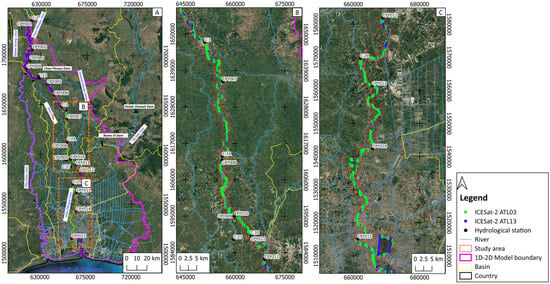
Figure 2.
(A) Overview of ICESat-2 ATL03 and ATL13 overpasses in the study area; (B,C) zoomed-in views of areas lacking ICESat-2 ATL13 data. All panels are based on the UTM Zone 47 North coordinate system. © Google Earth.
2.4. Surface Water and Ocean Topography (SWOT) Satellite
The Surface Water and Ocean Topography (SWOT) satellite mission, launched in 2022, is dedicated to observing Earth’s rivers [35] with a 21-day repeat cycle. This mission is led by NASA and Centre National D’Etudes Spatiales (CNES) with contributions from the Canadian Space Agency (CSA) and the United Kingdom Space Agency (UKSA). SWOT’s instrument is a Ka-band Radar Interferometer (KaRIn). KaRIn is a synthetic aperture radar (SAR) interferometer in Ka-band (35.75 GHz frequency or 8.6 mm wavelength) [35]. Figure 3A depicts the KaRIn operating system and its ground coverage, providing images of water elevations within two 50 km swaths. These two swaths are separated by a 20 km gap at the satellite nadir. KaRIn provides images of WSE with pixel sizes approximately 6 m in the azimuth direction and ranging from 60 m (near range) to 10 m (far range) in the range detection (Figure 3A). The SWOT track and swath overpassing the study area are shown in Figure 1D.
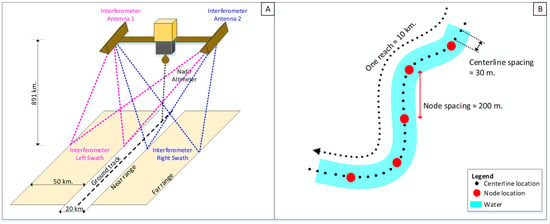
Figure 3.
SWOT satellite details: (A) SWOT’s viewing geometry, and (B) L2_HR_RiverSP product displaying the node of WSE.
SWOT’s measurements are the returned microwave power and range to the ground target and the difference in phase in the return signal received by both antennas. At near-nadir incidence angles, water is more reflective to Ka-band than land surfaces; therefore, the magnitude of the returned power is used to distinguish water from land [22,35].
The Physical Oceanography Distributed Active Archive Center (PO.DAAC) has prepared various products that incorporate travel times and locations determined using the built-in GPS from the SWOT satellite, generating 23 standard products as described by [36]. In this study, we used Level 2 KaRIn High-Rate River Single-Pass Vector Product version 2.0 (L2_HR_RiverSP_2.0) [37], which contains a record for each reach and for each node in shapefile format [38]. These records provide SWOT measurements of WSE and area. Additionally, for reaches, SWOT measurements include slope and discharge information over the length of the river covered by reach. The reaches are approximately 10 km in length and are divided into nodes along the reach centerline with a node-to-node spacing of approximately 200 m, as shown in Figure 3B. This study utilized the SWOT node product, derived from nodes in the L2_HR_RiverSP product, to extract WSE. This process is detailed in Section 3.3, and the SWOT node product is illustrated in Figure 1C. The SWOT data were obtained from the EARTHDATA SEARCH website via their data access tool (https://search.earthdata.nasa.gov/) accessed on 5 May 2024 and are described in more detail in Table 1.
2.5. Water Mask
A water mask was used to filter satellite data over land. This study utilized the Surface Water Extent (SWE) product from the WorldWater project, employing data from the Sentinel-1 and Sentinel-2 imaging satellites, which are both integral components of the European Space Agency (ESA) Copernicus program. The WorldWater SWE mapping utilized Sentinel-1 and Sentinel-2 data from 2017 to 2021 to develop a SWE dataset. This algorithm utilizes a fusion approach [39], combining optical and radar observations, to provide a more robust delineation of water surfaces. The SWE products provide information on water occurrence, monthly water presence, water seasonality, and maximum and minimum water extent, with a 10-meter spatial resolution. All data are accessible on the website: https://swdap.worldwater.earth/ (accessed on 1 December 2023). This study used a water occurrence threshold of more than 70 percent to filter satellite data over land, as shown in Figure 4.

Figure 4.
Water mask (A) ATL03 overlaid on Google Satellite imagery and (B) ATL03 overlaid on WorldWater’s water occurrence data. All panels are based on the UTM Zone 47 North coordinate system. © Google Earth.
2.6. In Situ Data
In this study, we collected in situ data from three agencies: the Royal Irrigation Department (RID), the Hydro-Informatics Institute (HII), and the Hydrographic Department of the Royal Thai Navy (NAVY). These data were used to set up hydraulic models, validate performance, and compare with the satellite-derived data. RID provided discharge and WSE data, including control structure release, on a daily time step. HII provided WSE data, and NAVY provided sea WSE data on an hourly time step. The in situ stations are depicted in Figure 1B. The available data cover the period from 1 January 2018 to 30 April 2024 and are described in more detail in Table 1.
3. Methods
The overview of the workflow used in this study includes different data processing, evaluation, and modeling steps, as illustrated in Figure 5. The method utilizes two different satellite data products, namely ICESat-2 ATL03 and SWOT, to evaluate the hydraulic model’s performance and the potential of satellites compared with in situ stations. The ICESat-2 ATL03 and SWOT products are processed (see Section 3.2 and Section 3.3) to estimate WSE time series along the river stretch for comparison with in situ WSE and simulated WSE.
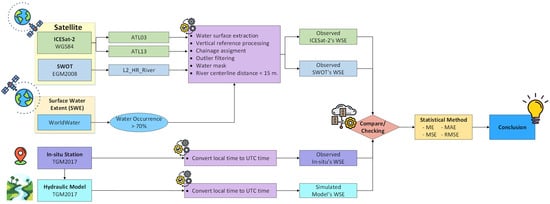
Figure 5.
Schematic diagram of the data processing and modeling workflow in this study.
3.1. Hydraulic Modeling Setup
The setup of the hydraulic model mirrored the original model from the decision support system (DSS) for flood forecasting and water management for the Chao Phraya (CPY) river basin (see Section 3.1), Thailand, retaining the same parameters to generate simulated WSE along the CPY river. The simulated WSE in the CPY river was produced using the hydraulic model from 2018 to 2024, with daily and hourly time steps [29]. The simulated WSE was initially generated in local time (Bangkok time, Thailand). To avoid timing discrepancies, the data were converted to Coordinated Universal Time (UTC). In this study, we employed the simulated WSE generated from the hydraulic model and evaluated it using satellite and in situ data.
3.2. ICESat-2 ATL03 Data Processing
The ICESat-2 ATL03 photon cloud product is used to estimate WSE, referred to as ATL03 WSE. To estimate ATL03 WSE in the CPY river, we employed the following approach:
- ▪ The ICESat-2 ATL03 data were processed to extract the following parameters: latitude (Lat_ph), longitude (Long_ph), height (h_ph) relative to the WGS84 ellipsoid, photon signal confidence (signal_conf_ph), and time (delta_time) in Coordinated Universal Time (UTC). To ensure data accuracy and relevance, only measurements within a 1-kilometer distance from the CPY river’s centerline were considered, as shown in Figure 6A.
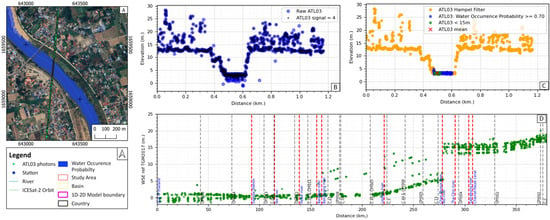 Figure 6. Overview of ICESat-2 ATL03 data processing: (A) ICESat-2 ATL03 photons over water occurrence, presented in the UTM Zone 47 North coordinate system; (B) raw ATL03 data (blue) and filtered ATL03 data (black) with a confidence signal level of 4 along the satellite track crossing the CPY river; (C) ATL03 outlier removal and selection based on water occurrence, proximity to the river centerline (within 15 m), and estimated WSE along the satellite track crossing the CPY river; (D) all estimated ATL03 WSE (green) along the CPY river. © Google Earth.
Figure 6. Overview of ICESat-2 ATL03 data processing: (A) ICESat-2 ATL03 photons over water occurrence, presented in the UTM Zone 47 North coordinate system; (B) raw ATL03 data (blue) and filtered ATL03 data (black) with a confidence signal level of 4 along the satellite track crossing the CPY river; (C) ATL03 outlier removal and selection based on water occurrence, proximity to the river centerline (within 15 m), and estimated WSE along the satellite track crossing the CPY river; (D) all estimated ATL03 WSE (green) along the CPY river. © Google Earth. - ▪ To evaluate WSE, it is necessary to use the same vertical datum reference. In this study, the vertical datum reference used was TGM2017 [40] to standardize the datum, which provides the best fit for Thailand. Equation (1) was used to establish accurate measurements of vertical elevation.
To obtain WSE referenced to TGM2017, EGM2008 height corrections were added to the WSE heights, and the TGM2017 geoid corrections were subtracted, as illustrated in Equation (2) detailed in the WSE product in Table 1.
- ▪ Subsequently, chainage points for the ICESat-2 ATL03 product were assigned following the same convention as the hydraulic model to ensure consistency. The ATL03 photons were filtered using the photon signal confidence (signal_conf_ph) parameter, which categorizes confidence levels into three groups: high (4), medium (3), and low (2) confidence. In this study, only ATL03 photons with a high confidence level (signal_conf_ph = 4) were utilized, following the approach described by [41,42], as illustrated in Figure 6B.
- ▪ To remove outliers from the photon cloud, we implemented the Hampel filter method [43] on the ATL03 photons to eliminate noise. The ATL03 photon products can mix the land elevation in between channels with WSE. To address this issue, we applied a water mask from Section 2.5, retaining only observations falling within water pixels with water occurrences higher than 70% (Figure 4B), as depicted in Figure 6C.
- ▪ Taking into account the river delineation extracted from the hydraulic model (Section 3.1), we only considered WSE points that were less than 15 m away from the river centerline. This ensures that ATL03 WSE points fall within the river during the low-flow period [44]. The WSE points within 15 m of the river centerline were averaged to provide unique observations for different dates at each chainage, as shown in Figure 6C. The total number of estimated ATL03 WSE was 1495 WSE, as shown along the CPY river in Figure 6D.
3.3. SWOT Data Processing
The nodes shapefile of the L2_HR_RiverSP product from the SWOT data were used to estimate WSE, referred to as SWOT WSE in the CPY river. We employed the following approach:
- ▪ The nodes shapefile of the L2_HR_RiverSP product were processed to extract the following parameters: latitude (lat), longitude (long), WSE (wse) relative to the EGM2008 geoid model, EGM2008 geoid height (geoid_hght) [45], and time (time) in UTC time scale. The details of these parameters are described in [38].
- ▪ Each simulated SWOT orbit track observes a different set of nodes, leading to varying numbers of observations for each node. To manage this variability, we applied a water mask from Section 2.5, selectively including only nodes falling within water pixels where water occurrence exceeds 70%, as shown in Figure 7A. Nodes were assigned chainage following the hydraulic model’s convention to maintain consistency.
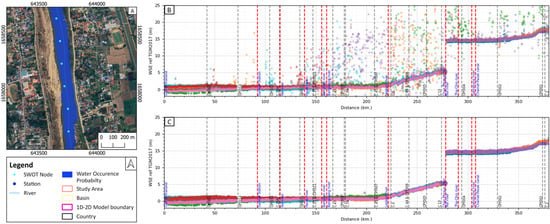 Figure 7. Overview of SWOT data processing: (A) SWOT nodes in water occurrence, presented in the UTM Zone 47 North coordinate system; (B) raw SWOT WSE along CPY river, and (C) SWOT WSE along CPY river after outline filter. © Google Earth.
Figure 7. Overview of SWOT data processing: (A) SWOT nodes in water occurrence, presented in the UTM Zone 47 North coordinate system; (B) raw SWOT WSE along CPY river, and (C) SWOT WSE along CPY river after outline filter. © Google Earth. - ▪ To evaluate WSE, it is essential to use a consistent vertical datum reference. The SWOT WSE was referenced using Equation (2), which converts the WSE reference from the EGM2008 geoid model to the TGM2017 geoid model.
- ▪ To remove noise from the SWOT WSE along the river profile, we implemented the Locally Weighted Regression and Smoothing Scatterplots (LOWESS) method [46]. The CPY river was divided into two river profiles at the CPY dam location to account for the notable differences in WSE profiles upstream and downstream of the dam, as shown in Figure 7B. To eliminate noise along the river profile in the SWOT WSE data, we applied a ±0.3 m range from the smoothed WSE profile using the LOWESS method for each date. This filtering process helps in obtaining a cleaner WSE profile by removing noisy data points that deviate significantly from the smoothed data, as shown in Figure 7C.
3.4. In Situ Data Processing
The in situ data were collected from Thai agencies (Section 2.6) on the local time scale (Bangkok time, Thailand). To avoid timing discrepancies, the in situ data were converted to the UTC scale to allow for accurate comparison with the WSE satellite products and simulated WSE.
3.5. Water Surface Elevation (WSE) Evaluation
To assess the accuracy and performance of the estimated WSE derived from satellite data and simulated WSE by the hydraulic model, we utilized various metrics, including bias (mean error, ME), mean absolute error (MAE), mean square error (MSE), and root mean square error (RMSE). These statistical methods were applied to evaluate both the model’s performance and the accuracy of the WSE satellite product.
where Ŷi represents the WSE for dimension 1, Yi denotes the WSE for dimension 2 as depicted in Table 2, and n is the number of observations.

Table 2.
The metric evaluation using WSE products from dimensions 1 and 2.
ME represents the average difference between WSE for dimensions 1 and 2, indicating systematic overestimation (positive) or underestimation (negative). A value near zero reflects minimal bias. MAE measures the average magnitude of errors between WSE for dimensions 1 and 2, irrespective of direction. Lower MAE values indicate better performance. MSE calculates the average squared difference between WSE for dimensions 1 and 2, penalizing larger errors. Lower MSE values reflect higher accuracy. RMSE is the square root of MSE, providing an error metric in the same unit as the data. Lower RMSE indicates better agreement between observed and predicted values.
4. Results
4.1. Hydraulic Model Calibration Results
The hydraulic model was calibrated using in situ WSE data from 2012 to 2013. The calibration results for the main rivers in the study area are detailed in [28], encompassing all major rivers with an average R2 of 0.96, RMSE of 0.30 m, and NSE of 0.90. Specifically, the calibration in the CPY river was found to be generally satisfactory, evaluated using data from 15 in situ stations, with an average R2 of 0.98, RMSE of 0.24 m, and NSE of 0.92.
4.2. ICESat-2 ATL03 Data Processing Results
Along the approximately 376 km stretch of the CPY river, 1495 ICESat-2 WSE points were derived from ICESat-2 ATL03 products, as illustrated in Figure 6C. The data products cover measurements from 2018 to 2024. ICESat-2 provides a good sample of WSE observations as explained in Section 2.3, ensuring coverage of the entire river reach with very few gaps. Additionally, the dataset’s temporal coverage includes both low-flow and high-flow seasons. This highlights the potential of the CPY dam to store water for irrigation during low-flow seasons and release water during high-flow seasons, as observed in the ATL03 WSE along the CPY river (Appendix A. ICESat-2 ATL03 data processing). As a result, the ATL03 WSE can be used to check for errors in hydraulic models, evaluate model performance, and validate ATL03 WSE findings using in situ data.
4.3. SWOT Data Processing Results
Initially, we utilized observations from 17 SWOT node products, providing measurements during low-flow seasons (26 Jan 2024–22 Apr 2024). These 17 SWOT node products contain 23538 WSE points along the CPY river, as depicted in Figure 7B. After applying the method described in Section 3.3, we obtained 12388 WSE observations, as illustrated in Figure 7C. The processing steps provide a comprehensive sample of WSE observations, with dense coverage across the entire river reach. The SWOT WSE dataset not only provides the WSE profile along the CPY river but also enables the monitoring of sea level intrusion due to its extensive coverage (Appendix B. SWOT data processing). As a result, SWOT WSE data can be used to identify errors in hydraulic models, evaluate model performance, and validate SWOT WSE findings using in situ data.
4.4. Evaluation of Water Surface Elevation (WSE) Data Products
Table 3 presents the overall average of the statistical results for the WSE evaluation between pairs of WSE products, as detailed in Table 2. The average ME of simulated WSE compared to WSE observation products was +0.18 m, +0.12 m, and +0.17 m for ATL03, SWOT, and in situ measurements, respectively, as shown in Figure 8A–C. This indicates that the simulated WSE is slightly higher than the observation products. The evaluation of simulated WSE in the CPY river was found to be generally satisfactory, assessed using observation products from three observation products, with an average RMSE of 0.36 m, 0.33 m, and 0.37 m for ATL03, SWOT, and in situ measurements, respectively.

Table 3.
Statistical metrics comparing water surface elevation (WSE) for various dimensions. The resulting averages are computed across the datasets within the study area. Pair comparison 1 (simulated—ATL03): Comparison between simulated WSE and ICESat-2 ATL03 WSE along the CPY river at each chainage where ICESat-2 ATL03 crosses. Pair comparison 2 (simulated—SWOT): Comparison between simulated WSE and SWOT WSE along the CPY river at each chainage where SWOT crosses. Pair comparison 3 (simulated—in situ): Comparison between simulated WSE and in situ WSE at 15 in situ stations along the CPY river. Pair comparison 4 (in situ—ATL03): Comparison between in situ WSE and ICESat-2 ATL03 WSE at in situ stations where ICESat-2 ATL03 crosses. Pair comparison 5 (in situ—SWOT): Comparison between in situ WSE and SWOT WSE at in situ stations where SWOT crosses and Pair comparison 6 (ATL03–SWOT): Comparison between the two satellite products, ICESat-2 ATL03 and SWOT WSE.
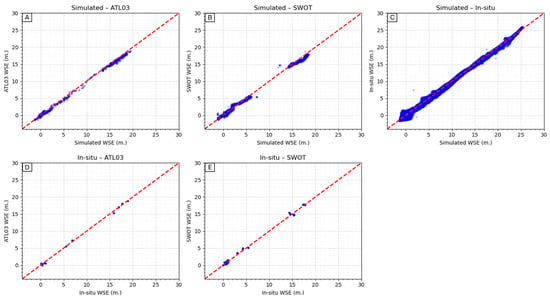
Figure 8.
The comparison of WSE between pairs: (A) simulated—ATL03; (B) simulated—SWOT; (C) simulated—in situ; (D) in situ—ATL03; and (E) in situ—SWOT.
The evaluations between WSE observation datasets show that the average ME of in situ WSE compared to satellite WSE observation products was +0.03 m and −0.10 m for ATL03 and SWOT, respectively, as depicted in Table 3. These results indicated that the satellite WSE products closely approximate the in situ WSE, as demonstrated in Figure 8D,E. The average performance statistics for ATL03 WSE and SWOT WSE, using in situ benchmarks, were as follows: 0.32 m and 0.33 m for MAE, 0.14 m and 0.16 m for MSE, and 0.34 m and 0.35 m for RMSE, respectively. However, a direct comparison between ATL03 and SWOT WSE is not feasible for evaluation due to their tracks not overlapping in time as shown in Figure A1.
Typically, model validation compares simulated WSE with observed WSE at specific locations or stations. Satellite data enable the evaluation of WSE along profiles, as depicted in Figure 9A,B, which compare the simulated WSE with ATL03 and SWOT WSE along the CPY river, respectively. The figure shows the simulated WSE profiles are in agreement with the satellite WSE profiles. (Further details are provided in Appendix A. ICESat-2 ATL03 data processing and Appendix B. SWOT data processing.) Moreover, the satellite WSE profiles can be utilized to assess errors in the simulated WSE generated by the hydraulic model, as depicted in Figure 10A for ATL03 WSE and Figure 10B for SWOT WSE. These figures illustrate the average residuals of simulated WSE and observation products along the CPY river. Figure 10A displays the average residual of the simulated—ATL03 comparison over the period from 21 November 2018 to 9 April 2024, while Figure 10B shows the average residual of the simulated—SWOT comparison from 26 January 2024 to 22 April 2024. Both figures demonstrate consistent trends in the direction of average residuals.
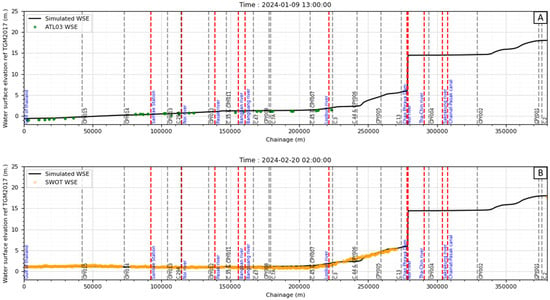
Figure 9.
WSE profile comparisons: (A) simulated—ATL03 WSE comparison on 9 January 2024, at 13:00:00, and (B) simulated—SWOT WSE comparison on 2 February 2024, at 02:00:00.

Figure 10.
The mean residual comparison of WSE between pairs: (A) simulated—ATL03, (B) simulated—SWOT along the CPY river, and (C) CPY river profile.
Figure 10 indicates that the simulated WSE notably overestimates the satellite WSE products between chainages 380 km and 330 km (between C.2 and CPY002 station), with differences reaching up to +1.2 m. The average residuals of simulated WSE compared to satellite WSE products between chainages 330 km and 280 km (between CPY002 station and CPY dam) were highly accurate. This accuracy is attributed to the simulated WSE profile generated by the hydraulic model, which incorporated observed data from operations at the CPY dam. These chainages demonstrate that the elevation of WSE is maintained for water storage at the CPY dam, serving multiple purposes including irrigation, consumption, flood protection, and saline intrusion prevention. Between chainages 280 km and 260 km (between CPY dam and CPY005 station), an overestimation in average WSE occurs, with residuals rising up to +0.5 m. Subsequently, residuals sharply decrease to −0.5 m from chainages 260 km to 220 km (between CPY005 and C.3 station). This indicates that the simulated WSE was overestimated between chainages 280 km and 260 km, whereas it was underestimated between chainages 260 km and 220 km. Chainages between 220 km and 0 km (between C.3 station and the Gulf of Thailand) show average residuals varying between −0.5 m and +0.5 m. These variations are influenced by fluctuations in sea levels. Moreover, an overall view of different statistics along the CPY river is presented in Figure A5, which illustrates the RMSE of WSE between pairs: A) simulated—ATL03 and B) simulated—SWOT comparison, as shown in Figure A5A and Figure A5B, respectively. The RMSE along the CPY river ranges from 0.1 to 1.2 m, depending on the chainage.
The evaluation of WSE along with profiles can be visualized in spatial maps of average residuals for WSE comparisons, as shown in Figure 11. Figure 11A,B illustrate the overall spatial distribution of performance characteristics along the CPY river, showing the distribution of mean error or bias for simulated—ATL03 and simulated—SWOT WSE comparisons, respectively. These figures highlight the potential to view errors along the river chainage, providing an overall perspective on error distribution and patterns, which align with the WSE profile evaluation described in Figure 10. Additionally, the spatial distribution of performance statistics, specifically the RMSE of WSE between pairs, can be illustrated: (A) simulated—ATL03 and (B) simulated—SWOT comparison, as presented in Figure A6A,B.
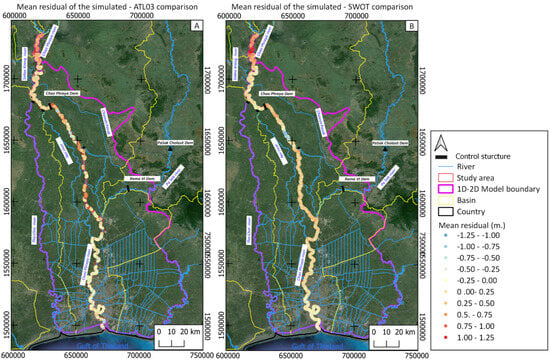
Figure 11.
Overview of the spatial distribution of performance characteristics along the CPY river. The distribution of mean error or bias of WSE between pairs: (A) simulated—ATL03 and (B) simulated—SWOT. All panels are based on the Universal Transverse Mercator (UTM) Zone 47 North coordinate system. © Google Earth.
5. Discussion
5.1. ICESat-2 Data Selection
ICESat-2 data provide valuable information for evaluating river hydraulic modeling. In this study, we utilized two ICESat-2 products to estimate WSE: ATL03 and ATL13. These differ in their suitability for rivers of varying widths and environmental conditions. Typically, ICESat-2 ATL13 products are employed for estimating WSE in inland surface water bodies wider than 100 m, as described in Section 3.2. The ICESat-2 ATL13 product is suitable for lakes or reservoirs and large rivers such as lakes or reservoirs [15,20,47], the Upper Yangtze River [16], and the Mekong River [48], where water surface widths are typically greater than the limitation of the water mask in ICESat-2 ATL13 process. The ICESat-2 ATL13 products cover these areas consistently. Figure 2A illustrates that ICESat-2 ATL13 covers consistently from the upstream of the CPY river to the CPY dam, where the width ranges from approximately 200 to 300 m. However, in narrower sections of the CPY river (widths between 50 and 200 m), as depicted in Figure 2B,C, the coverage of ICESat-2 ATL13 data in the CPY river becomes less consistent. This limitation is significant in Thailand, where rivers typically range in width from 30 to 1200 m [49], suggesting that ICESat-2 ATL13 products may not be well-suited for rivers in Thailand.
In contrast, ICESat-2 ATL03 processing is more appropriate for estimating WSE in these narrower rivers, providing better coverage and accuracy for the Thai river systems. As described in Section 3.2, ICESat-2 ATL03 provides precise WSE estimates by utilizing a higher-resolution point-based approach, making it more effective for Thai river systems which estimated 1145 WSE data points over a total of 87 time steps. This method provides a well-defined estimate of WSE points by referencing a precise datum and effectively removing background noise and outliers. Outlier filtering was conducted based on criteria including water occurrence and river centerline, successfully removing most outliers while preserving high-quality observations. However, caution is advised when using this method due to the specified limits of the river centerline criteria, which may impact the estimation of ATL03 WSE. Additionally, ICESat-2 data are affected by weather conditions because the laser altimeter cannot penetrate thick clouds. This results in gaps in WSE along river profiles.
The accuracy of ATL03 WSE is crucial for monitoring, model performance evaluation, and error checking in hydraulic models. The overall performance of the in situ—ATL03 WSE comparison showed an average ME of 0.03 m and an RMSE of 0.34 m, as shown in Table 3. These results are similar to those observed in the Yangtze River [16], the Murray River [21], India [14], Turkey [20], and China [15] which had an average RMSE range of 0.12–0.40 m. The error between ICESat-2 and in situ data might be due to the in situ locations, as some are installed close to bridges. Additionally, the shallow depths of many inland and nearshore water bodies can result in a possible bottom backscatter component affecting the overall water interaction [50].
5.2. SWOT Data Selection
The SWOT processing, as described in Section 3.3, estimated 12388 WSE points over a total of 17 time steps. The SWOT WSE data provide denser coverage of the CPY river compared to the ATL03 WSE data. However, since the 17 time steps cover only the low-flow season, this limited period affects error checking in the hydraulic model and evaluation using in situ data. The overall performance of the in situ—SWOT WSE comparison showed an average ME of −0.10 m and an RMSE of 0.35 m, as shown in Table 3. This result has been previously confirmed in studies such as Peace–Athabasca delta [51], where the RMSE reached up to 0.70 m. The accuracy of SWOT WSE measurements is influenced by several factors: beam blockage, terrain layover, multipath propagation caused by the reflection of radar signals, and bright roofs [22,52,53,54]. However, SWOT data provide valuable information for evaluating river hydraulic modeling and monitoring.
In this study, we utilized the SWOT node product to estimate WSE for checking errors in the hydraulic model. We implemented a WSE parameter (wse), which was aggregated to produce the node-level WSE using the heights of each pixel assigned to the node weighted by their uncertainties. The estimated SWOT WSE to node consists of applying the vertical reference to the ellipsoid-relative pixel-cloud heights to obtain the pixel WSE for all pixels. These pixel WSE values are then aggregated into node-level WSE values using a metric to estimate the mean height distribution over the feature. The optimal linear aggregator is the weighted average, where the weights are chosen to minimize the variance (or uncertainty) of the estimate, as described in [55]. The estimated SWOT WSE node error includes pixel misassignment errors, PIXC quantity inaccuracies, and reach phenomenology biases [55].
The SWOT processing provides a well-defined estimate of WSE points by referencing a precise datum and effectively removing noise and outliers, successfully preserving high-quality observations. Additionally, the implemented LOWESS method can effectively remove noise. Some research combines a truncated singular value decomposition and a slope-constrained least-squares estimator [25] to smooth profiles. However, the effectiveness of noise removal methods along river profiles depends on the behavior of the area. In this study, the presence of control structures to maintain upstream water levels and the impact of sea levels influenced the WSE profiles.
In addition to the SWOT node products used in this study, other SWOT products can be utilized to monitor lakes, reservoirs, and rivers, as well as for calibration, validation, evaluation, and error checking in flood models. Examples of this include the following:
- (1)
- The L2_HR_LakeSP product provides WSE, area, and storage change data for monitoring lakes and reservoirs.
- (2)
- The L2_HR_Raster product provides spatial WSE and inundation extent maps. This product can be implemented in models such as data assimilation [23,56,57,58] and compared with WRF-Hydro [59].
- (3)
- The L2_HR_FPDEM product provides a floodplain digital elevation map in raster format, which can be used to monitor and compare simulated flood maps from flood modeling in terms of depth and area such as [52].
5.3. Model Performance
In this study, we conducted three WSE comparisons, namely simulated—ATL03, simulated—SWOT, and simulated—in situ as explained in Table 2. These WSE comparisons were used to evaluate and check errors in the model performance within the Chao Phraya flood forecasting system, focusing on the CPY river using new datasets.
The overall performance of the simulated—in situ WSE comparison showed an average RMSE of 0.37 m along the CPY river from 2018 to 2024 as shown in Table 3 and in the comparisons for each station in Figure A2 and Figure A3. In contrast, the previous performance presented an average RMSE of 0.24 m [28] from 2012 to 2013. This represents a model performance decrease of approximately 54.17 percent in terms of RMSE, indicating a significant decline when evaluated with in situ data in the new period.
The ATL03 WSE is considered valuable information from a new source to test the model performance, as it represents new and previously unobserved locations and a new time period. The results reveal that the overall performance of the simulated—ATL03 WSE comparison showed an average RMSE of 0.36 m along the CPY river from 2018 to 2024 as shown in Table 3. The total number of ATL03 WSE observations was 1145 WSE over 87 time steps, covering both high and low flow conditions, and spanning 499 locations along the CPY river. Similarly, SWOT WSE represents a new dataset and new period compared to the ATL03 WSE. The results show that the overall performance of the simulated—SWOT WSE comparison showed an average RMSE of 0.33 m and an average ME of 0.12 m along the CPY river for 2024, as shown in Table 3. The total estimated SWOT WSE was 12388 WSE points over 17 time steps, covering only low flow conditions, and spanning 1764 locations. The performance of the simulated—SWOT WSE evaluation was higher than that of the simulated—in situ and simulated—ATL03 WSE comparisons. The SWOT WSE data were collected over a short period and only under low-flow conditions. In contrast, the simulated—in situ and simulated—ATL03 WSE comparisons span a longer period and include both high- and low-flow conditions.
ATL03 WSE and SWOT WSE data are much denser compared to in situ measurements, which are available from only 15 stations along the CPY river. The WSE evaluation can be presented along the CPY river profile, as shown in Figure 10A and Figure A5A from the simulated—ATL03 WSE evaluation, and Figure 10B and Figure 11B from the simulated—SWOT WSE evaluation. Additionally, spatial maps display these evaluations in Figure 11A and Figure A6A from the simulated—ATL03 WSE evaluation, and Figure 11B and Figure A6B from the simulated—SWOT WSE evaluation, respectively. These figures also highlight the potential for errors between chainages as explained in Section 4.4. Moreover, these findings emphasize the importance of targeted interventions based on the spatial distribution of errors. By identifying and addressing areas with significant simulated discrepancies, more effective and efficient management strategies can be implemented.
However, the overall performance of the simulated—ALT03 WSE and simulated—SWOT WSE comparison does not differ when compared to the simulated—in situ WSE comparison due to factors described in Section 5.1 and Section 5.2. The ATL03 WSE and SWOT WSE provide broader error-checking coverage than in situ stations, allowing for performance evaluation along the river profile and in spatial maps. However, there are limitations of the satellites regarding the length of time traversing (repeat cycle and time latency) the study area, and processing including factors described in Section 5.1 and Section 5.2. Therefore, a combined use of in situ data, ATL03 WSE, and SWOT WSE is useful to improve the performance of the hydraulic model. Based on the presented WSE comparison, the potential sources for a decrease in the performance of the hydraulic model are summarized as follows:
- ▪ Cross-section survey data: The hydraulic model incorporated cross-section survey data collected between 2009 and 2013 for the CPY river. The use of this older data affects the representation of the cross-sectional area and river width as inputs to the hydraulic model, leading to errors in the simulated WSE, particularly in the delta areas. Notably, between chainages 380 km and 330 km, the bottom level of the CPY cross-section profile is higher than that of the adjacent bottom level, resulting in simulated WSE values that are higher than both ATL03 WSE and SWOT WSE, with a mean residual of +1.2 m. Conversely, between chainages 250 km and 230 km, the bottom level is lower than that of the adjacent bottom level, leading to simulated WSE values that are lower than both ATL03 WSE and SWOT WSE, with a mean residual of −0.5 m, as shown in Figure 10. Similar challenges have been observed in studies of the Niger Delta [60], Pacific Ocean, and Japan sea [61] and are relevant to our study area.
- ▪ Water management data: Thailand has many agencies relevant to water management, such as RID, HII, and NAVY, as explained in Section 2.6. Additionally, other water agencies, such as the Metropolitan Waterworks Authority (MWA) provide clean and safe water for public consumption; the Provincial Waterworks Authority (PWA) sources and procures raw water for use in the water supply; and the Department of Drainage and Sewerage (DDS) of the Bangkok Metropolitan Administration (BMA) manages drainage and flood control in Bangkok city. Furthermore, approximately 80 percent of the study area is fully irrigated. These activities impact the flow in the CPY river through pumping operations, but these data were not included in the hydraulic model due to a lack of available data, leading to decreased performance of the simulated WSE. As described by [62], the exclusion of these data led to discharge losses of around 52% from the CPY river. Notably, at a chainage of 96.8 km, the Samlae station operated by MWA pumps approximately 40–50 m³/s to supply drinking water, which was not included in the model.
- ▪ Water management plan data: There are ongoing implementations of water management plans in the study area, such as the Ayutthaya Bypass channel [63] at an upstream chainage of 156.6 km and a downstream chainage of 120 km, along with ongoing land use changes in the lower CPY basin [64], which impact WSE simulations.
- ▪ Hydraulic model: The process of river hydraulic modeling integrates both hydrological and hydraulic data to simulate river flow and water levels. The performance of the hydraulic model is affected by various factors, such as input data, parameters, control structures, and hydraulic geometry [65]. Additionally, the simulated runoff from the hydrological model contributes to this uncertainty. Meanwhile, the main objectives of the hydraulic model from the operational flood forecasting system are flood warning and flood prediction. The hydraulic model primarily focuses on high-flow conditions. As shown in Figure A3, the simulated WSE performs well under high-flow conditions, whereas it overestimates in situ data under low-flow conditions.
In summary, the simulated—in situ WSE evaluation;, simulated—ATL03 WSE evaluation; and simulated—SWOT WSE evaluation indicate that the hydraulic model needs improvement. The discrepancies observed in these evaluations highlight areas where the model’s accuracy can be enhanced along the river profile. Specifically, the comparison between simulated and satellite WSE under different flow conditions shows critical positions that need improvement. Additionally, the model’s sensitivity to input data and parameters requires refinement of spatially distributed input parameters. Addressing these issues will lead to more reliable flood forecasting and improved water management strategies, ensuring that the model can accurately predict and respond to varying hydrological conditions.
5.4. Model Improvement
As discussed in Section 5.3, the hydraulic model needs improvement to enhance the performance of the CPY flood forecasting system. The results of the study effectively highlight model errors along the CPY river, as presented in profiles and spatial maps where areas with the worst and best performance can be identified. These insights can be used to target specific locations and areas for improvement. However, the focus of this study was on error diagnosis in hydraulic models using satellite data, and hence no adjustments or improvements were made to the hydraulic model, and additional data collection was not conducted. We propose the following to enhance the model’s performance:
- ▪ Cross-section survey: Cross-section data serve as the primary input for the hydraulic model, which simulates cross-sectional area and water level. Updating cross-section data is necessary to keep it current, especially between chainages 380 km and 330 km, and downstream of the CPY dam, from chainage 270 km to 220 km. However, collecting survey data is costly and time-consuming. Estimating the effective cross-section shape using satellite earth observation [48,66] is a viable alternative to reduce the cost and time required for updates.
- ▪ Water management and water management plan data: Collaboration between water management agencies to share data, along with the installation of real-time telemetry, is essential for developing more robust models.
- ▪ Resistance coefficients: Manning’s roughness coefficient [67] is used in the hydraulic model to estimate the mean velocity and discharge in open channels, representing the resistance to flow in channels and floodplains. Adjusting this coefficient can significantly enhance model accuracy, for example by using seasonal variations in Manning’s roughness coefficient [68] or by integrating satellite data (SWOT) to improve roughness estimates along the river [69].
- ▪ Integrating comprehensive data sources: To further enhance model accuracy and reliability, it is crucial to combine various data sources. Integrating in situ data, ATL03 WSE, and SWOT WSE from this study will provide a more comprehensive dataset, allowing for a more robust calibration and validation process and ultimately improving the hydraulic model’s performance.
This research provides an example of successfully leveraging satellite laser altimetry from ICESat-2 and radar altimetry from SWOT for error diagnosis in hydraulic models. Results from this study for the CPY river suggest that this approach can identify and map model errors in space and time. Our study demonstrates that the potential of these error diagnosis methods extends our study area. This highlights the versatility and potential widespread use of our approach in improving flood forecasting systems and other areas.
6. Conclusions
This paper introduces a workflow leveraging satellite laser altimetry from ICESat-2 and radar altimetry from SWOT to enhance hydraulic modeling by diagnosing errors. This approach enables the estimation of WSE along rivers using ICESat-2 and SWOT data. By employing ICESat-2 ATL03, which is well-suited for Thailand’s narrow rivers, alongside SWOT data, the workflow achieved high accuracy in WSE estimation, with RMSE values of 0.34 m and 0.35 m, respectively, when compared to in situ measurements. The study highlights the common challenge of achieving suitable availability and quality of WSE datasets for hydraulic model development, evaluation, error diagnosis, and monitoring, especially in areas with limited instrumentation along rivers.
The CPY river served as the primary study area, where the integration of ICESat-2 and SWOT data demonstrated significant potential to diagnose errors and enhance the performance of hydraulic models. Comparisons of the CPY hydraulic model with observational datasets yielded RMSE values of 0.36, 0.33, and 0.37 for in situ, ICESat-2 ATL03, and SWOT data, respectively. These findings highlight the need for model refinement to further improve flood forecasting accuracy. The evaluation of WSE profiles through spatial maps and profiles proves to be efficient in pinpointing errors and facilitating improvements in hydraulic modeling.
Furthermore, the study results demonstrate that integrating these workflows enhances the efficiency of hydraulic models and highlights the potential of leveraging Earth observation (EO) satellite data to improve flood modeling capabilities for operational flood forecasting in Thailand and beyond.
Author Contributions
T.C.: Conceptualization, Methodology, Validation, Formal analysis, Investigation, Data curation, Visualization, Writing—review and editing, and Writing—original draft. J.L.: Software and Review. P.B.-G.: Methodology, Conceptualization, Resources, Supervision, and Writing—review and editing. All authors have read and agreed to the published version of the manuscript.
Funding
This research received no external funding.
Data Availability Statement
The raw data supporting the conclusions of this article will be made available by the authors on request.
Acknowledgments
We gratefully acknowledge the Hydro-Informatics Institute (HII), DHI A/S, and the WorldWater project for providing historical observed data, in situ data, Chao Phraya’s 1D-2D flood models, MIKE powered by DHI software version 2020, and water surface extent data. This study received no funding. Their unwavering support and invaluable contributions have been instrumental in the fruition of this work.
Conflicts of Interest
Author Jakob Luchner was employed by the company DHI A/S. The remaining authors declare that the research was conducted in the absence of any commercial or financial relationships that could be construed as a potential conflict of interest.
Appendix A. ICESat-2 ATL03 Data Processing
In the main text, only the comparative results, example processes, and datasets showing available dates of satellite crossings over the study area are presented. The appendix provides the results for the remaining processes and comparisons. Appendix A. ICESat-2 ATL03 data processing includes ICESat-2 ATL03 data processing (Appendix A.1) and the comparison between simulated WSE derived from the hydraulic model and ATL03 WSE from the ICESat-2 satellite at various time intervals (Appendix A.2). Appendix B. SWOT data processing illustrates the comparison between simulated WSE derived from the hydraulic model and SWOT WSE from the SWOT satellite at various time intervals. Finally, Appendix C. Water surface elevation (WSE) evaluation displays the simulated—in situ WSE comparison in station graphs (Appendix C.1), river profiles, and spatial maps (Appendix C.2).

Figure A1.
Available dates for ICESat-2 (green) and SWOT (orange) crossing over CPY river.
Appendix A.1. Illustrates the ICESat-2 ATL03 Data Processing for Each Chainage on 21 November 2018
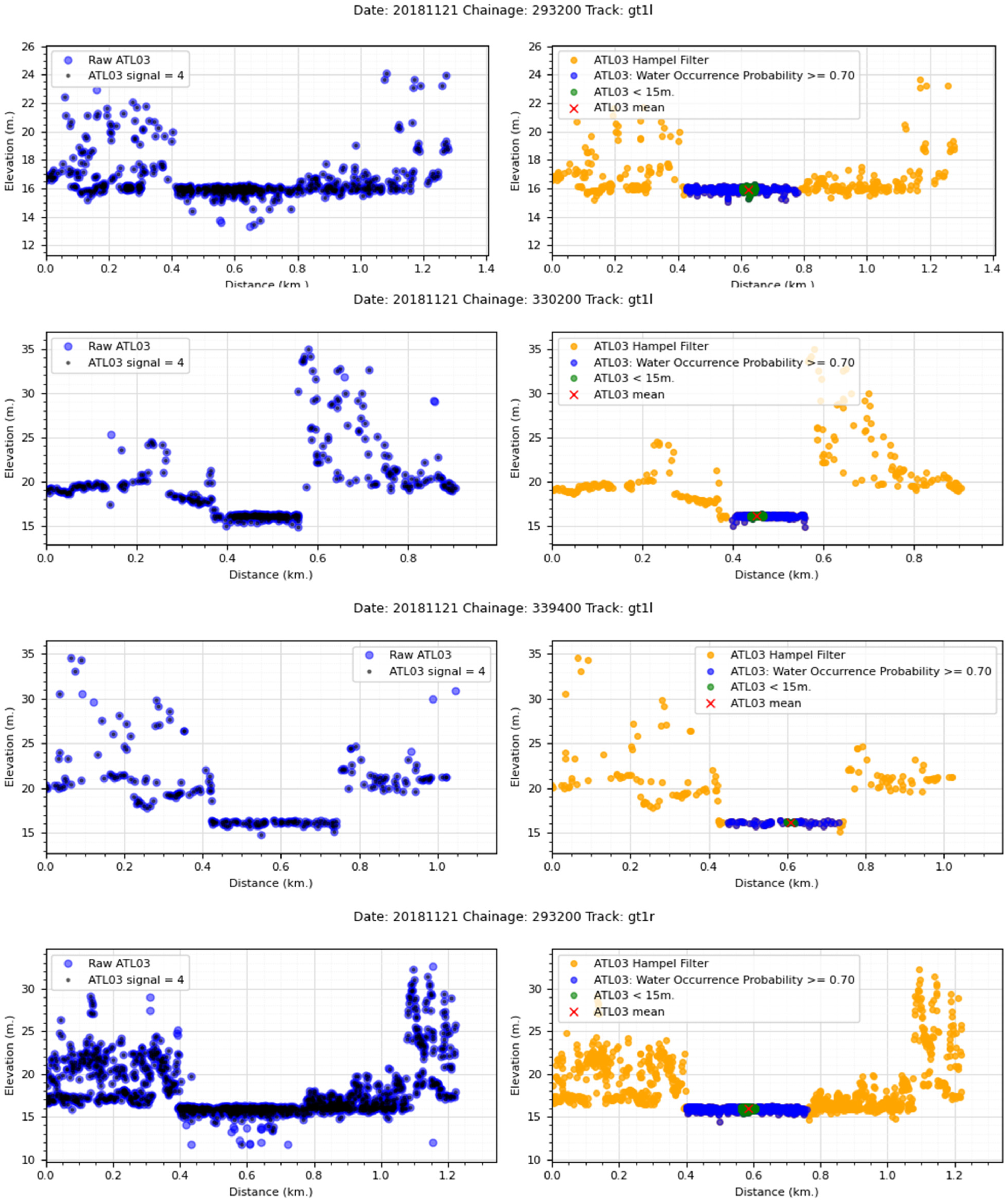
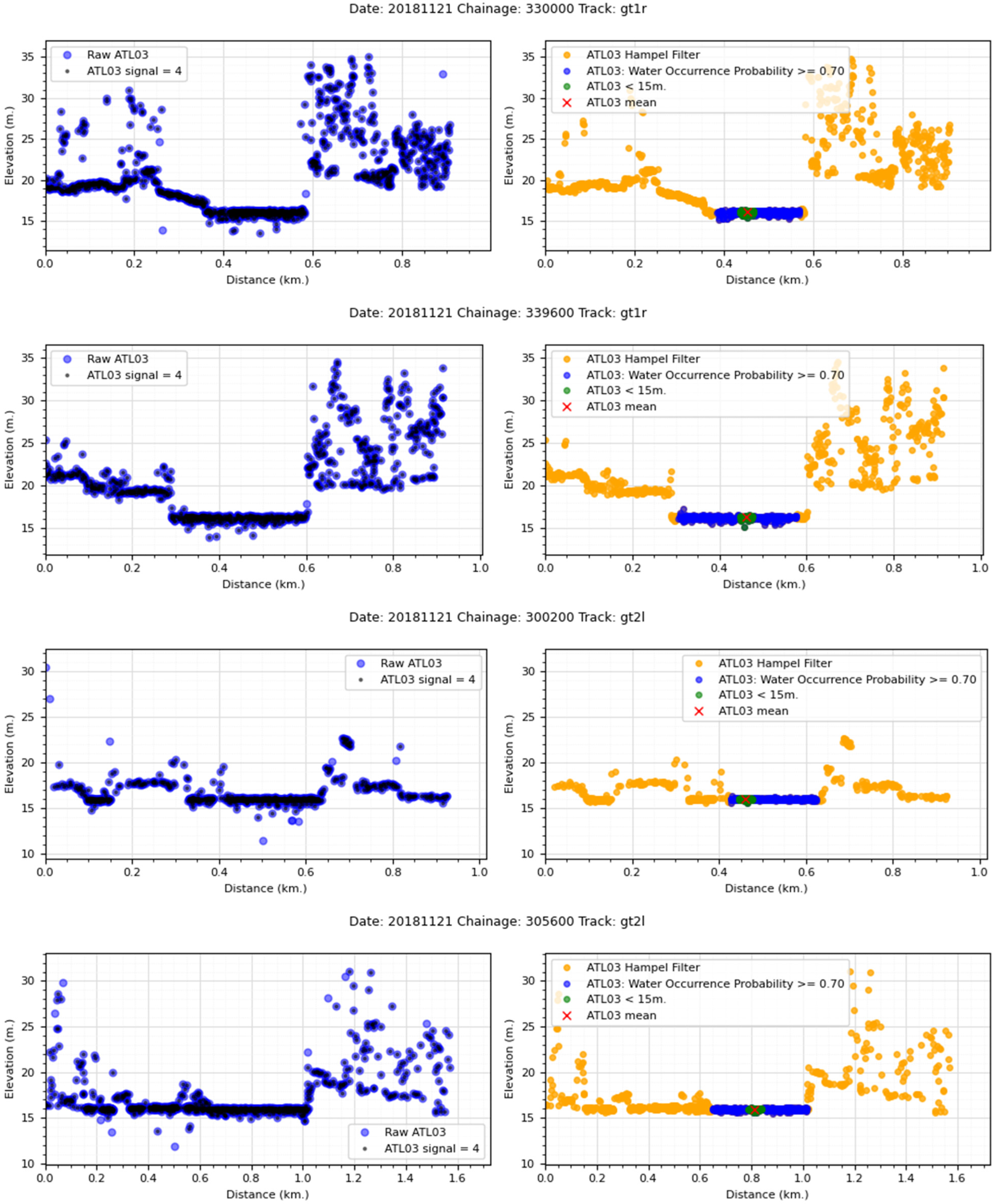

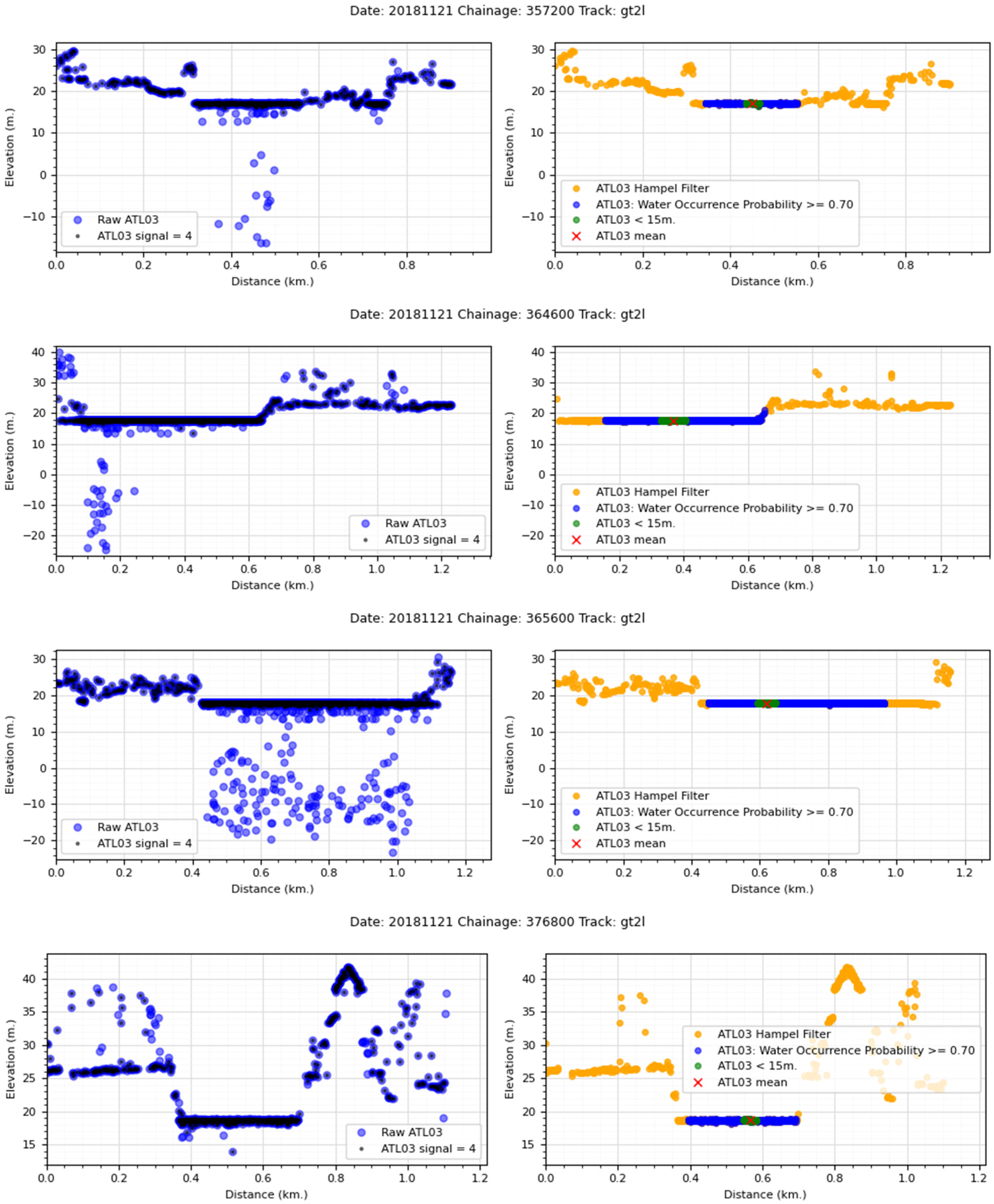
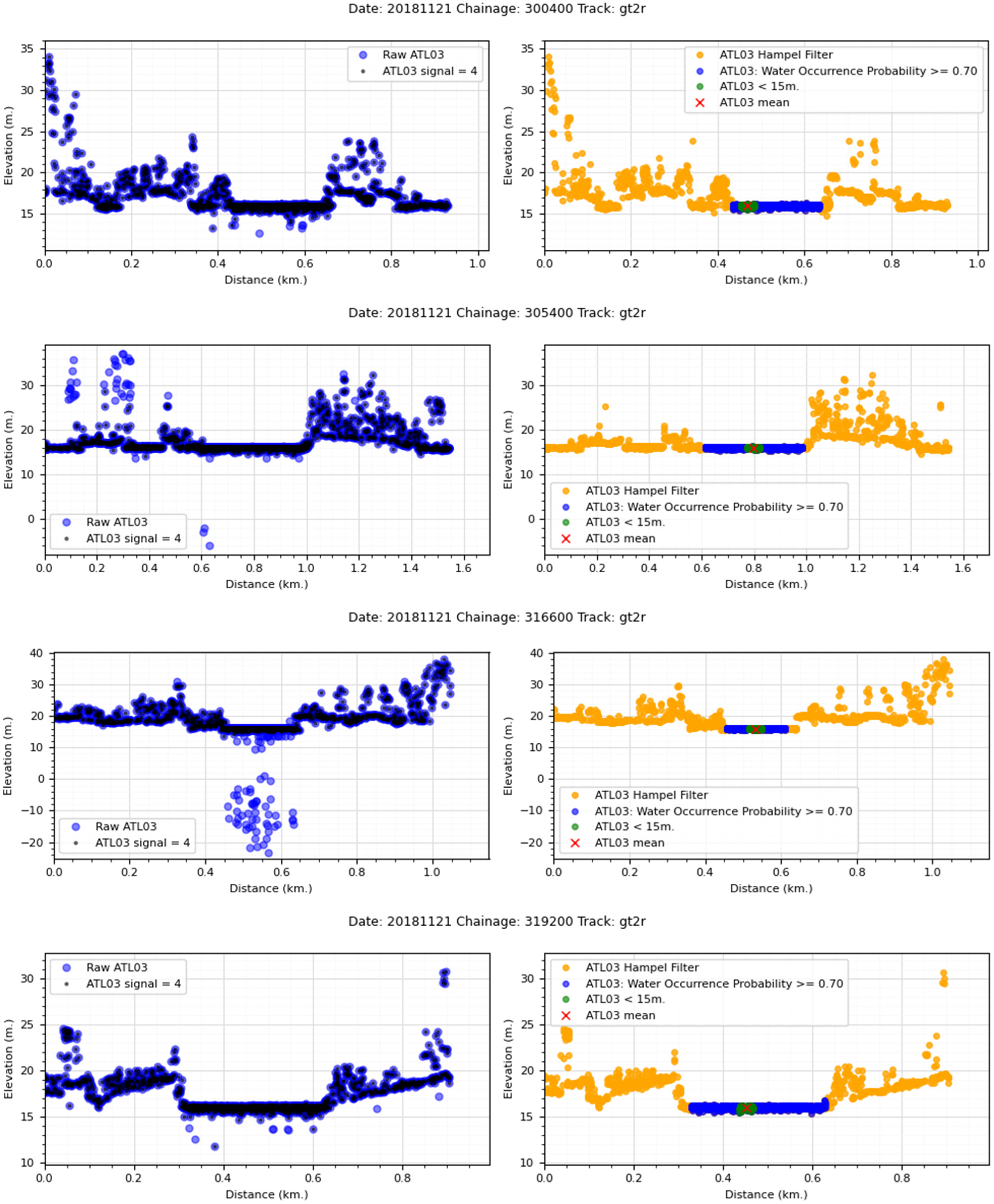
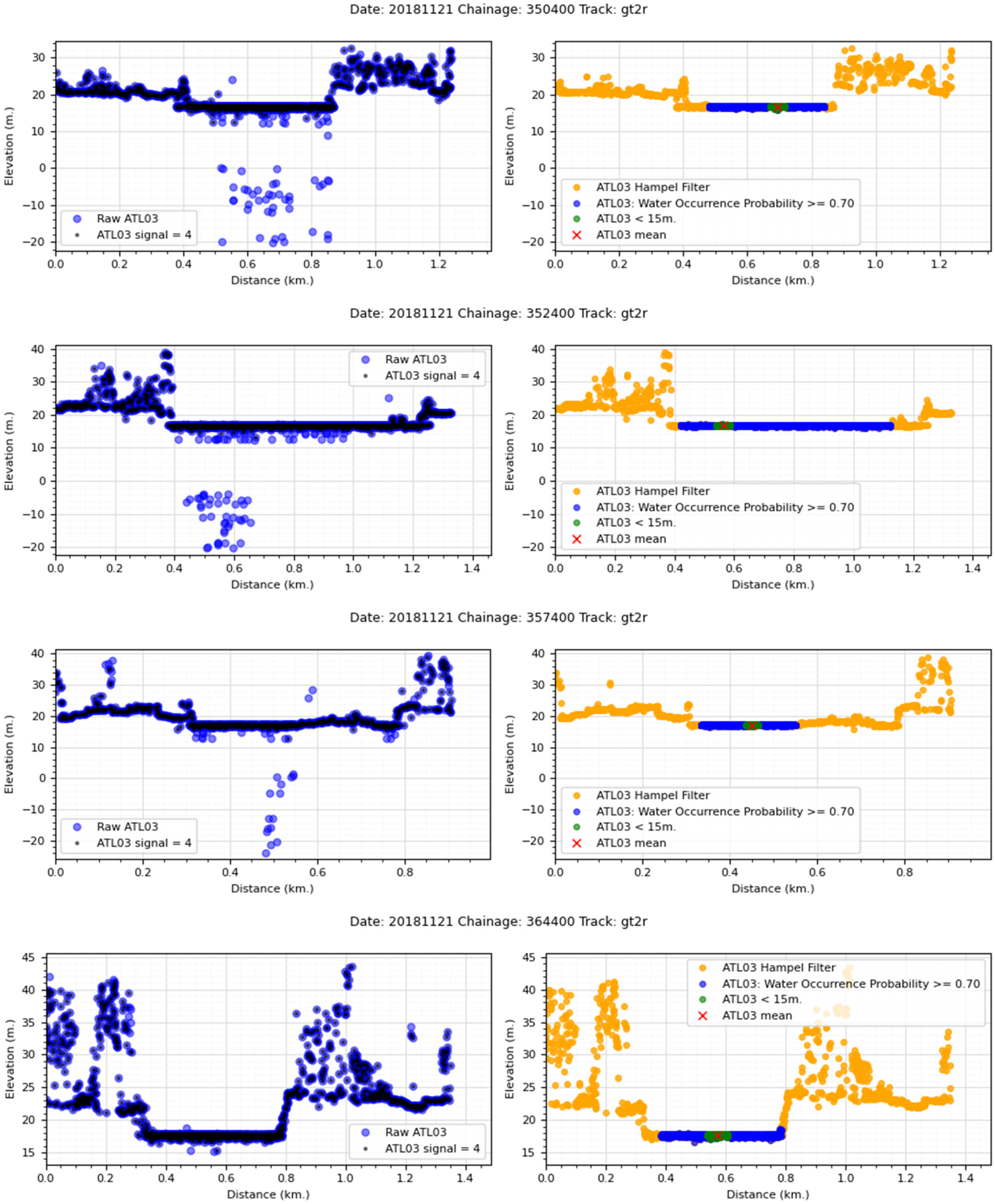
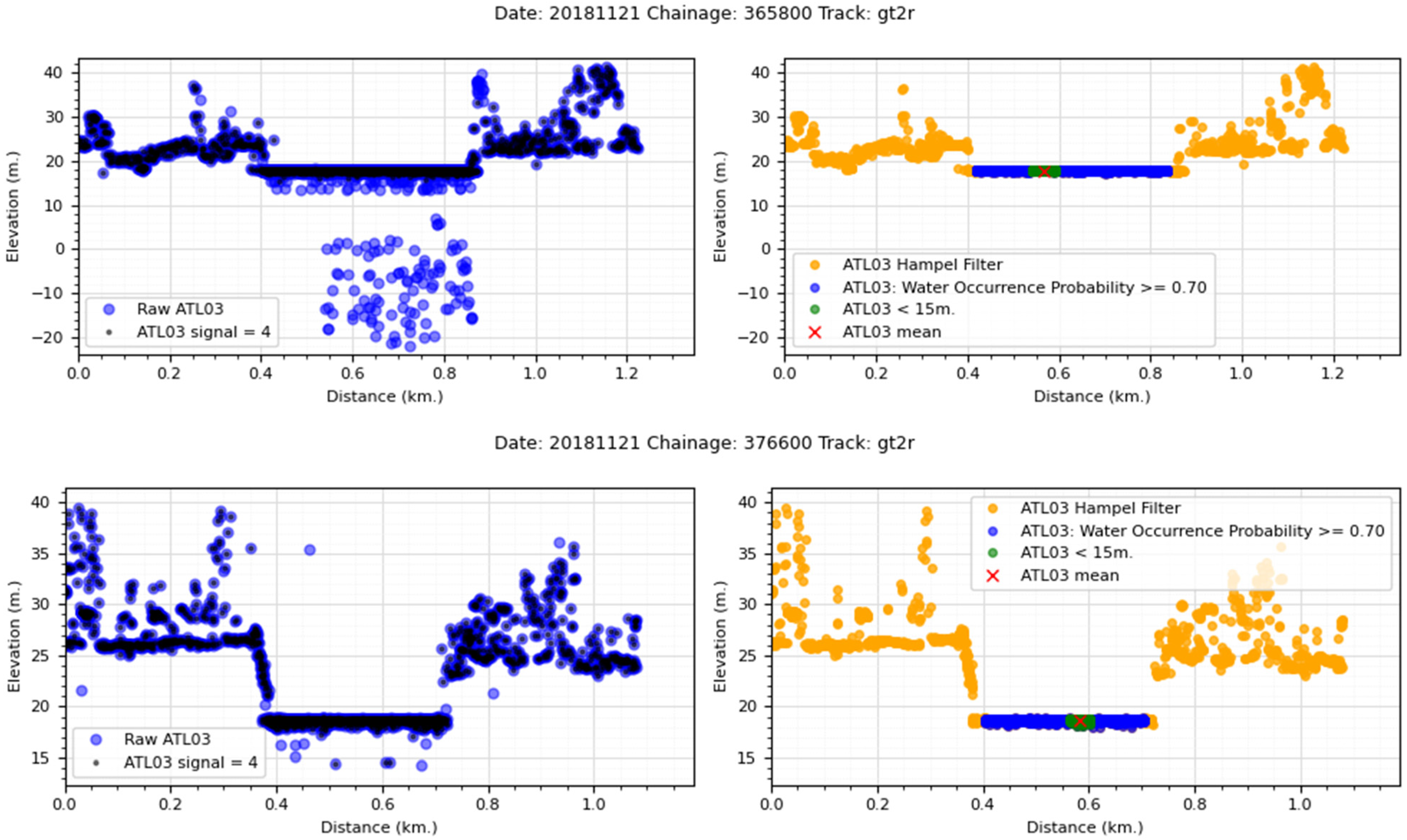
Appendix A.2. Illustrates the Comparison Between Simulated WSE Derived from the Hydraulic Model and ATL03 WSE from ICESat-2 at Various Time Intervals
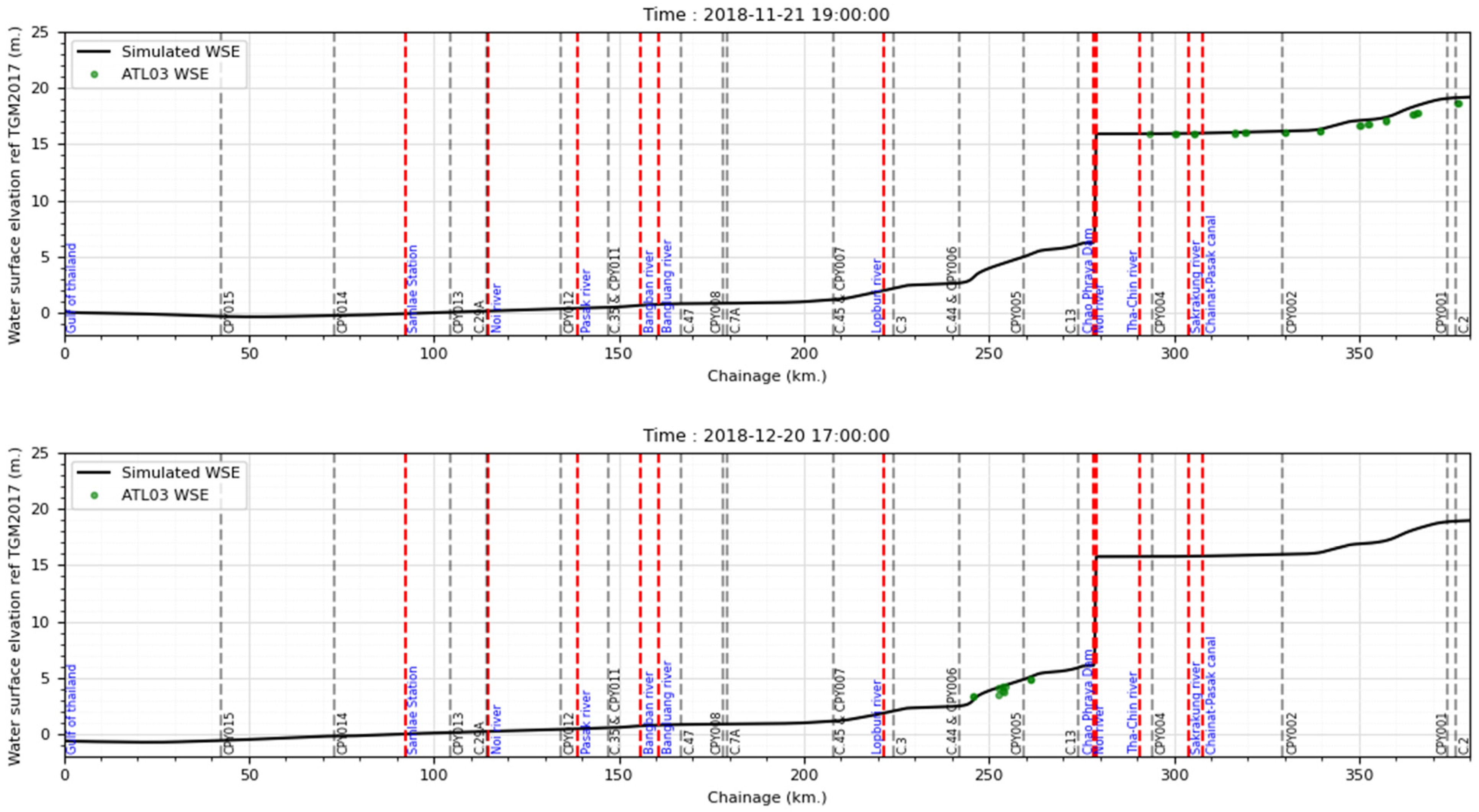
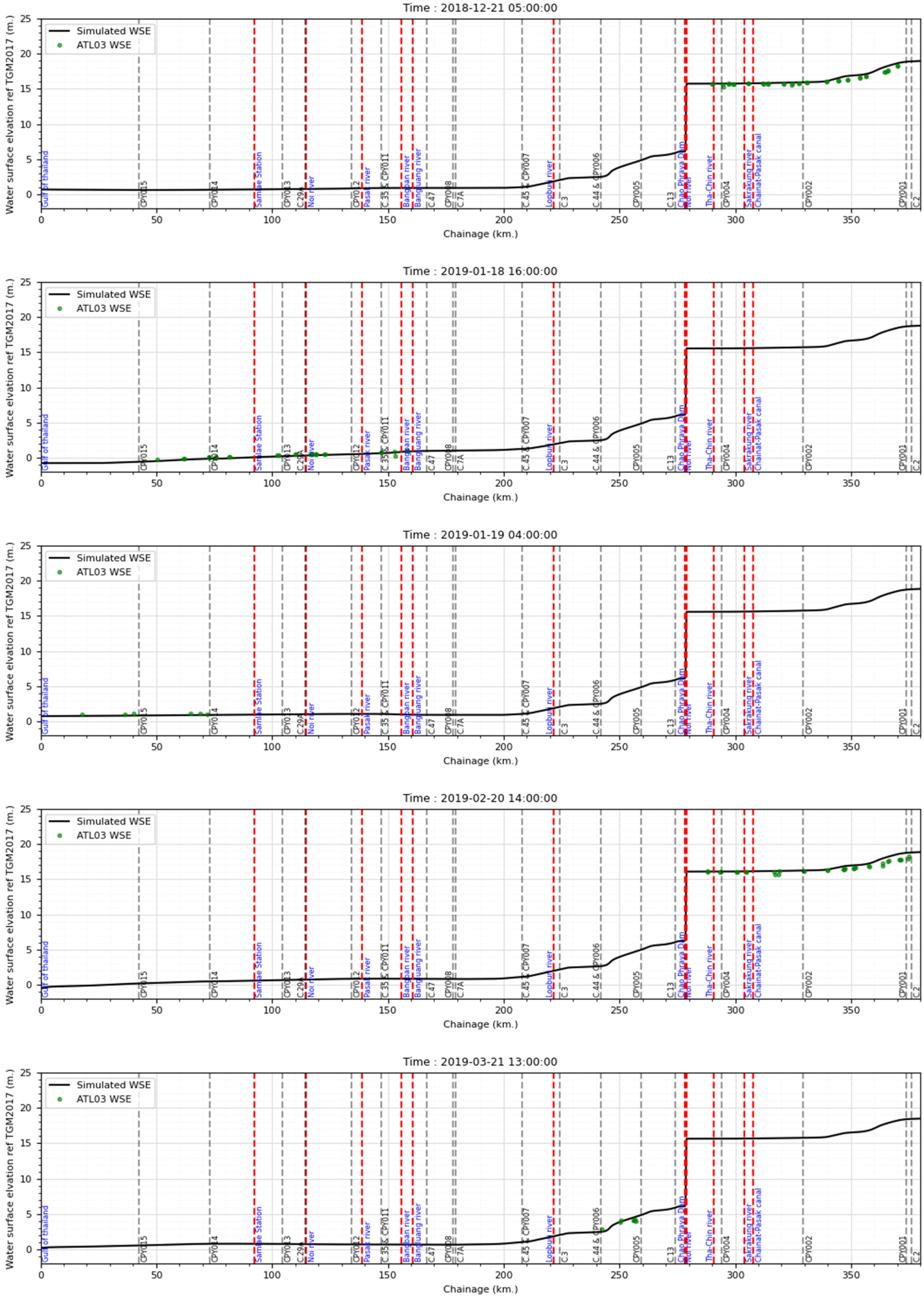
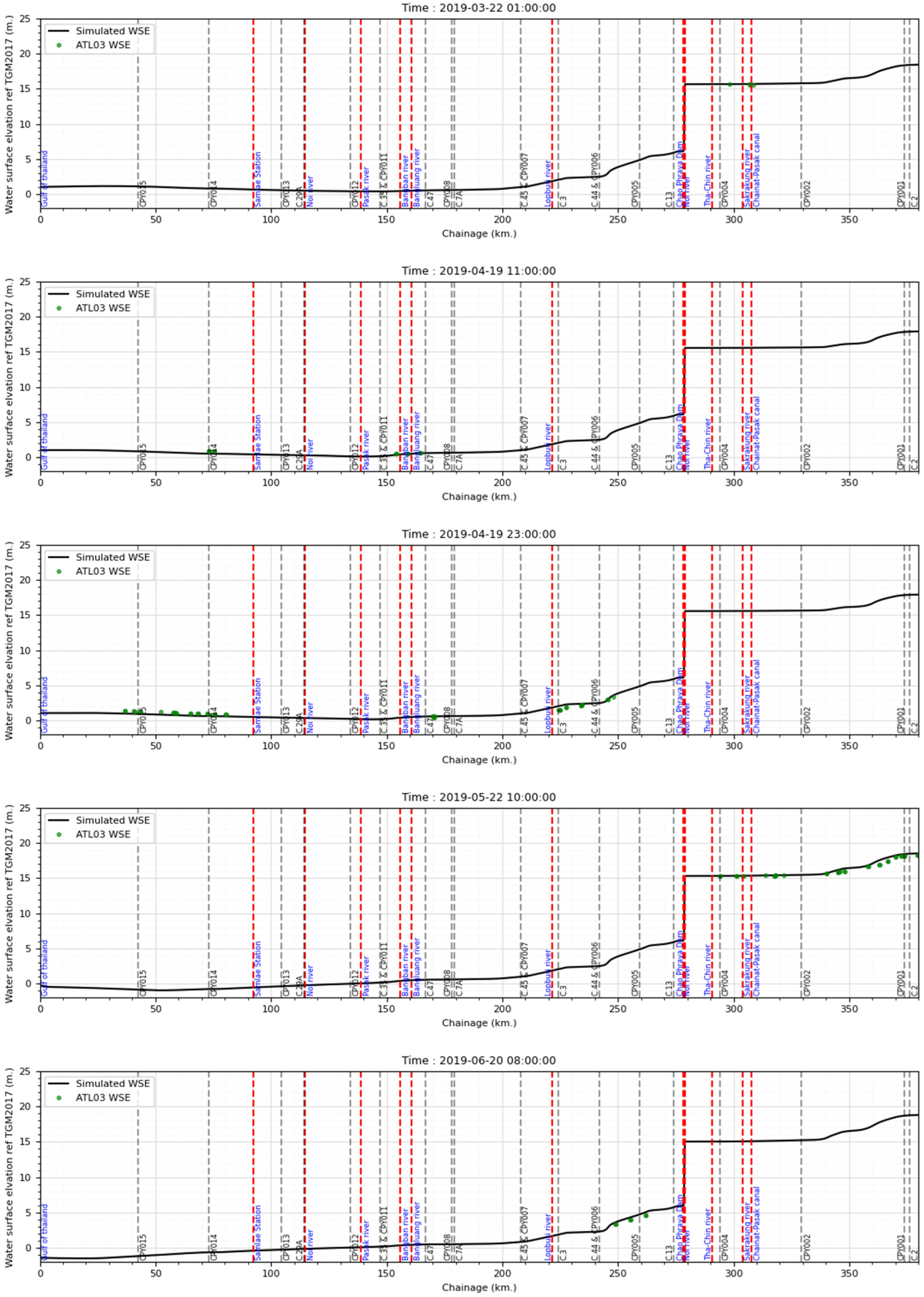
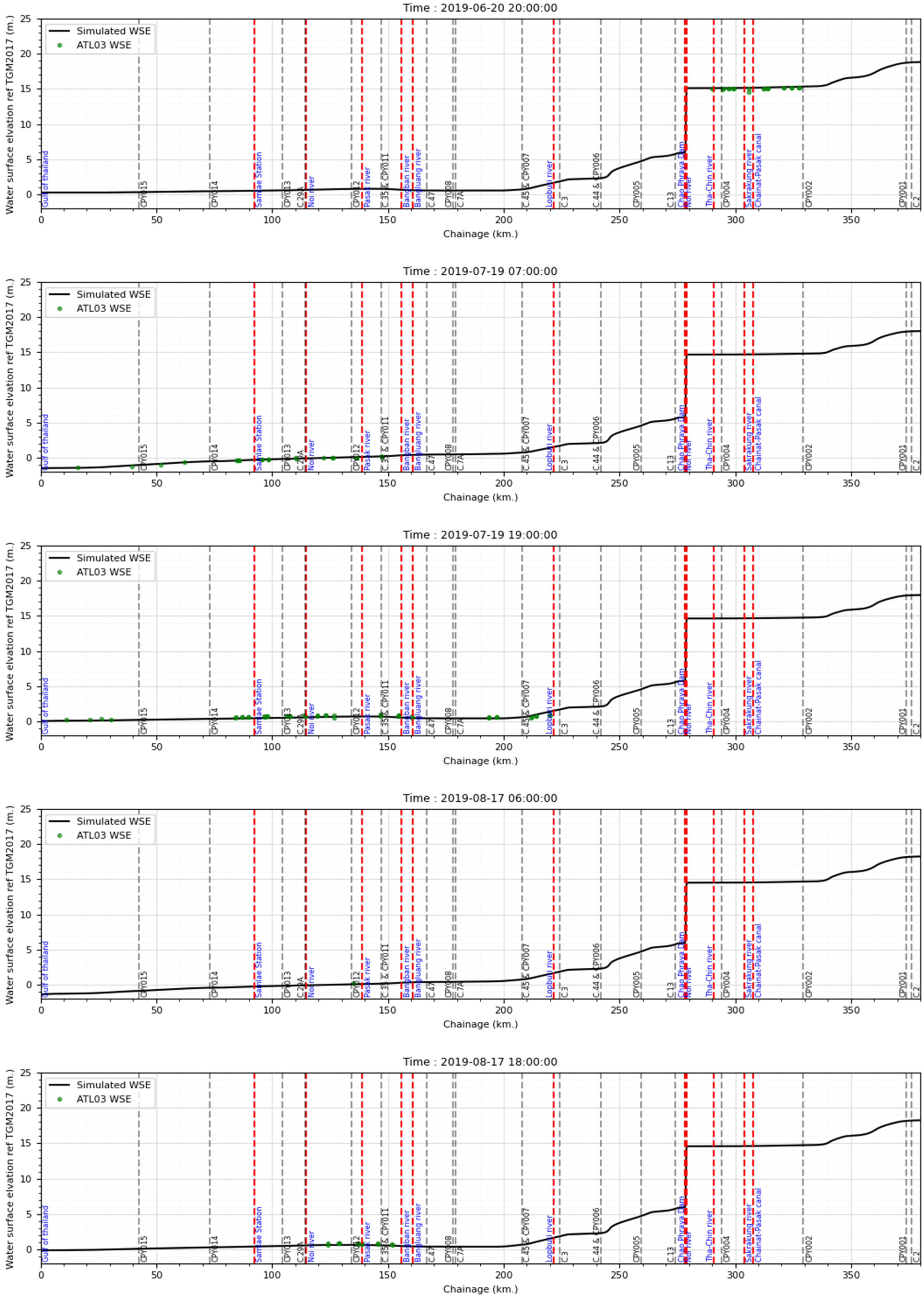
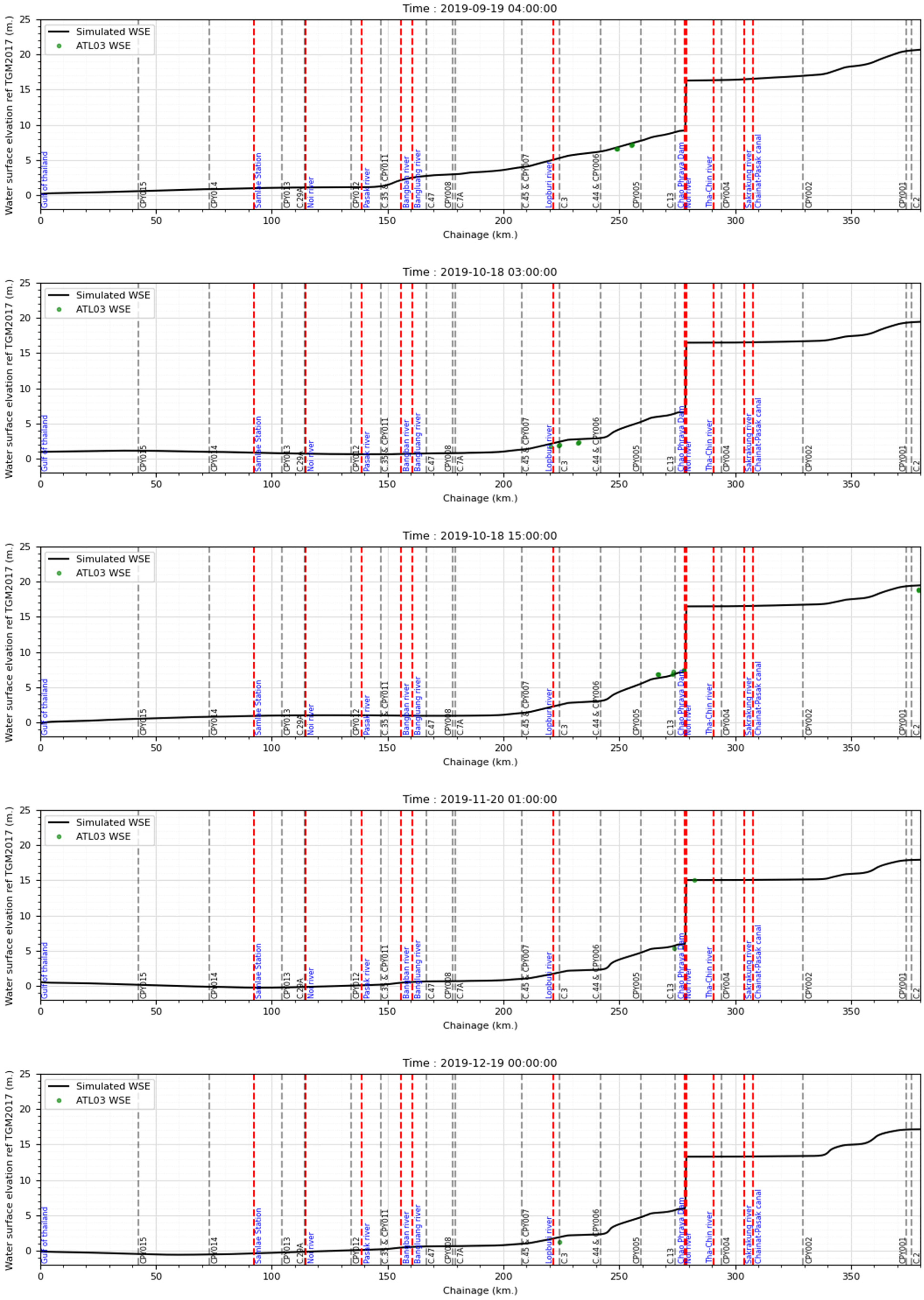
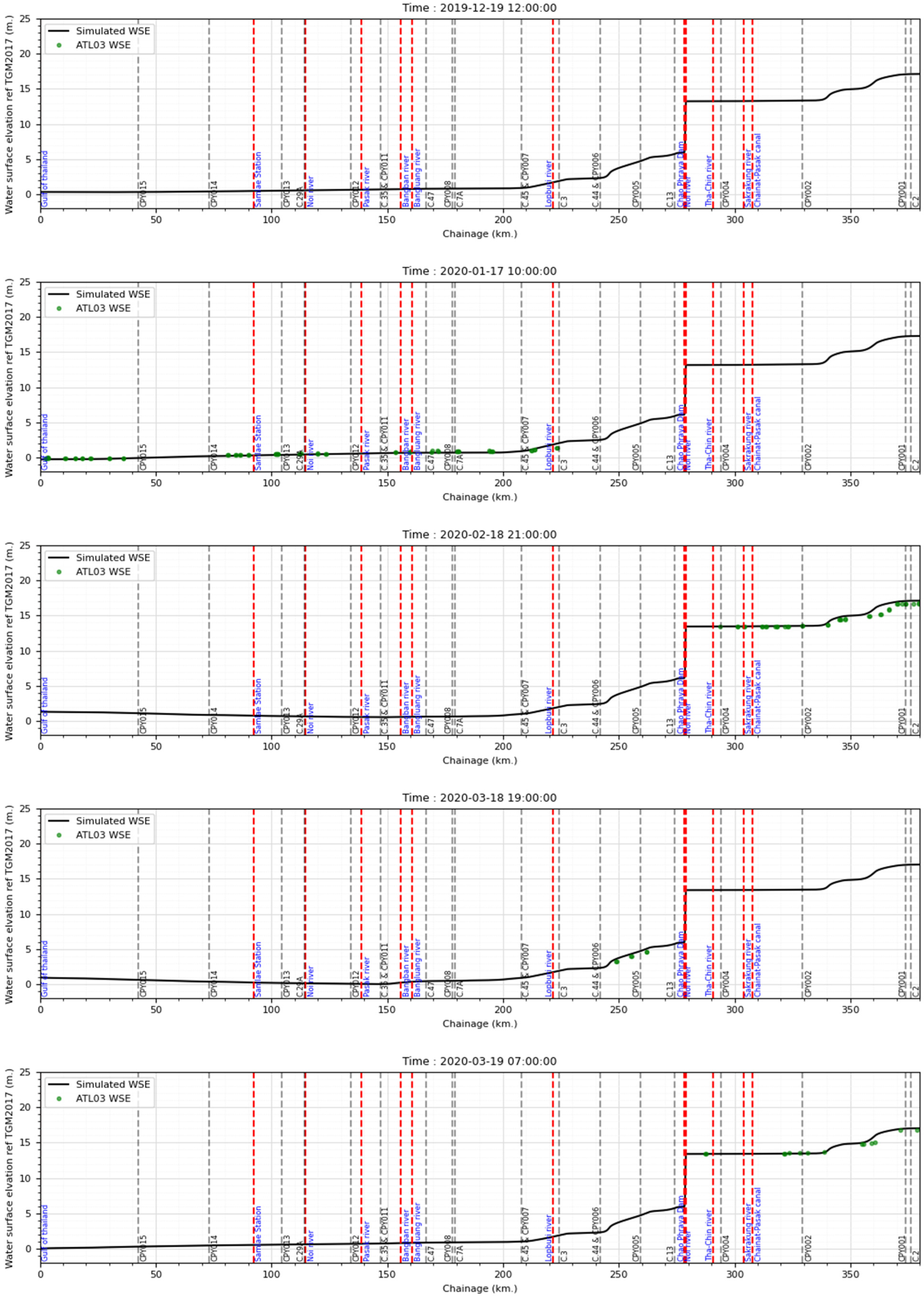
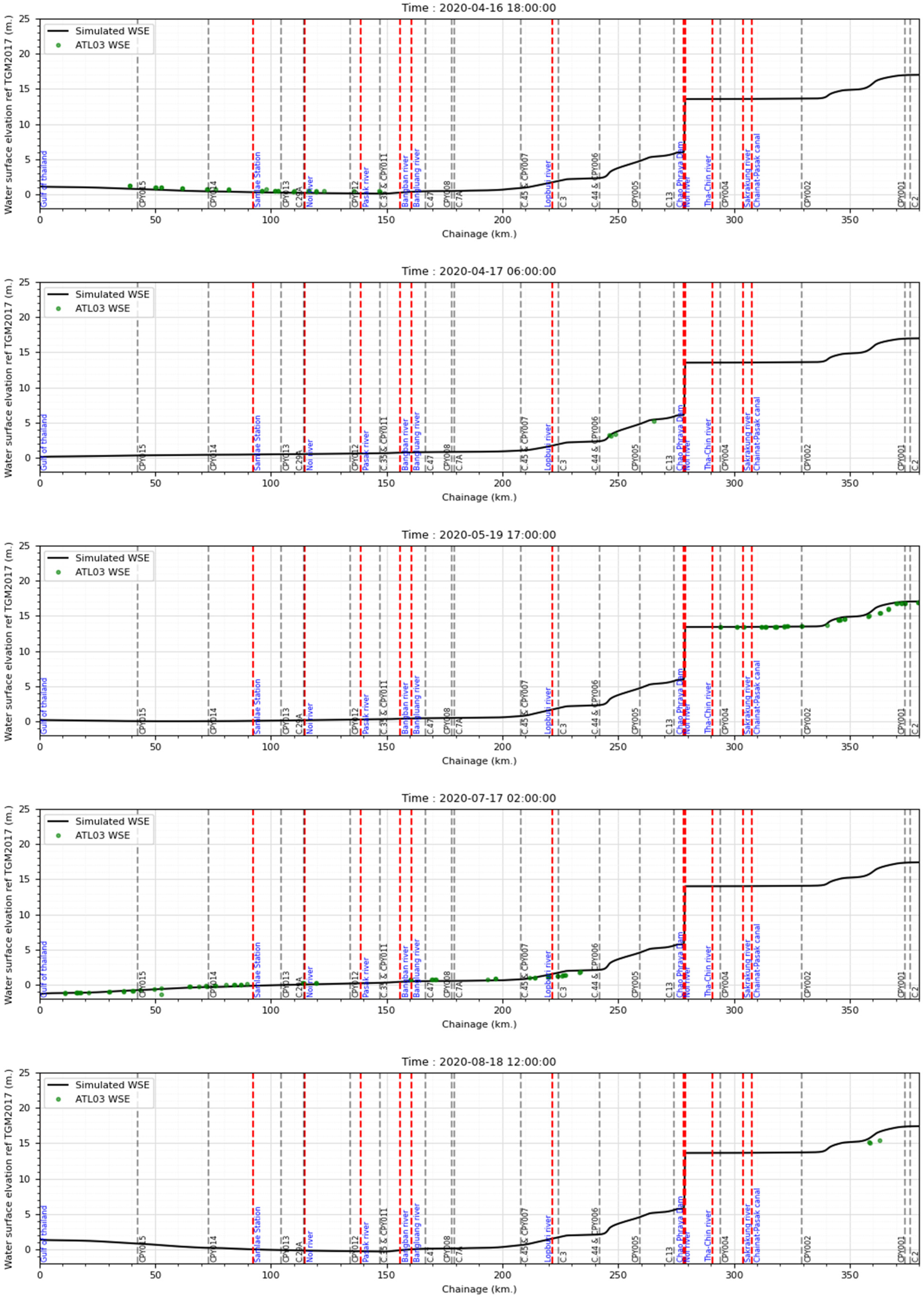
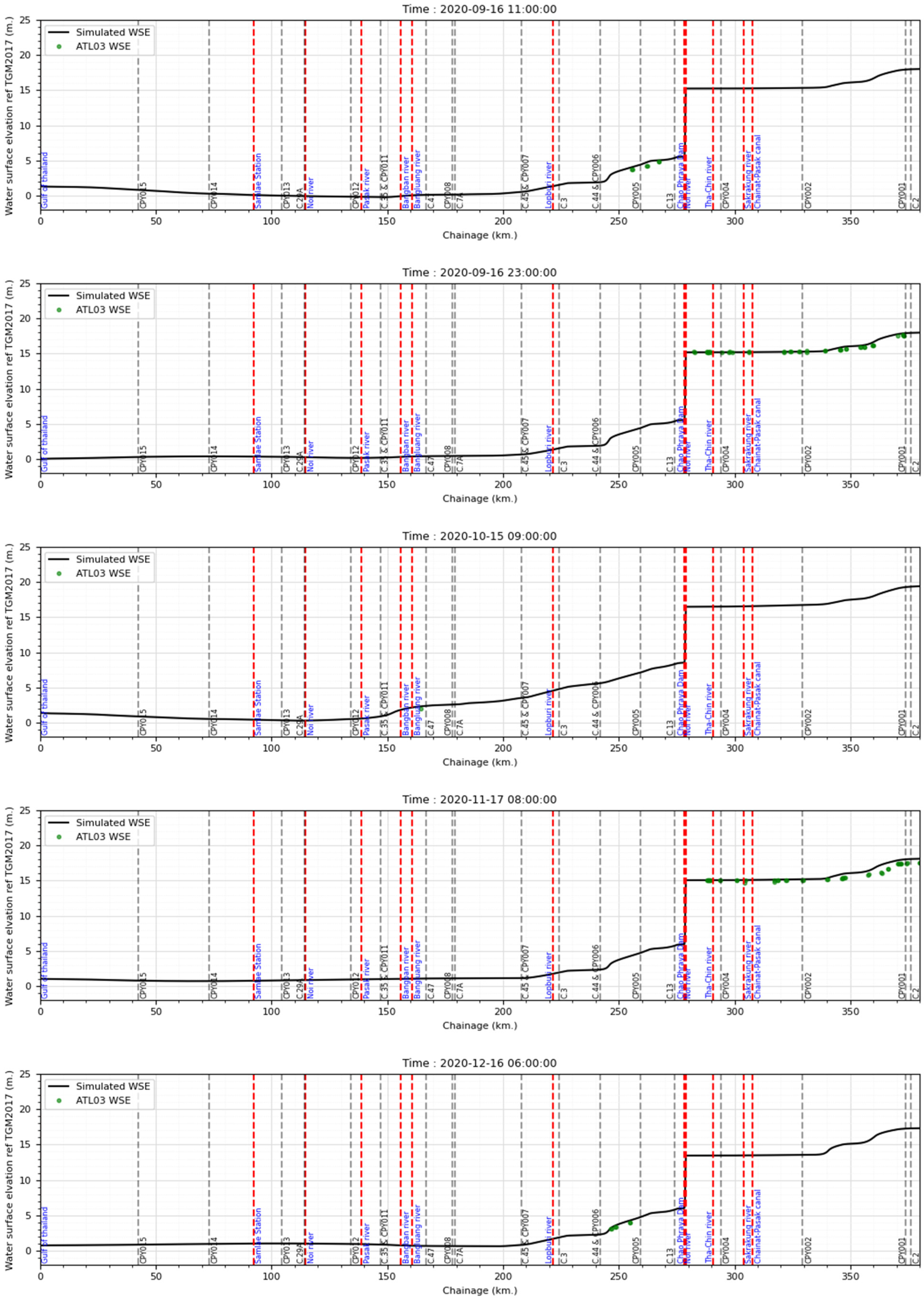
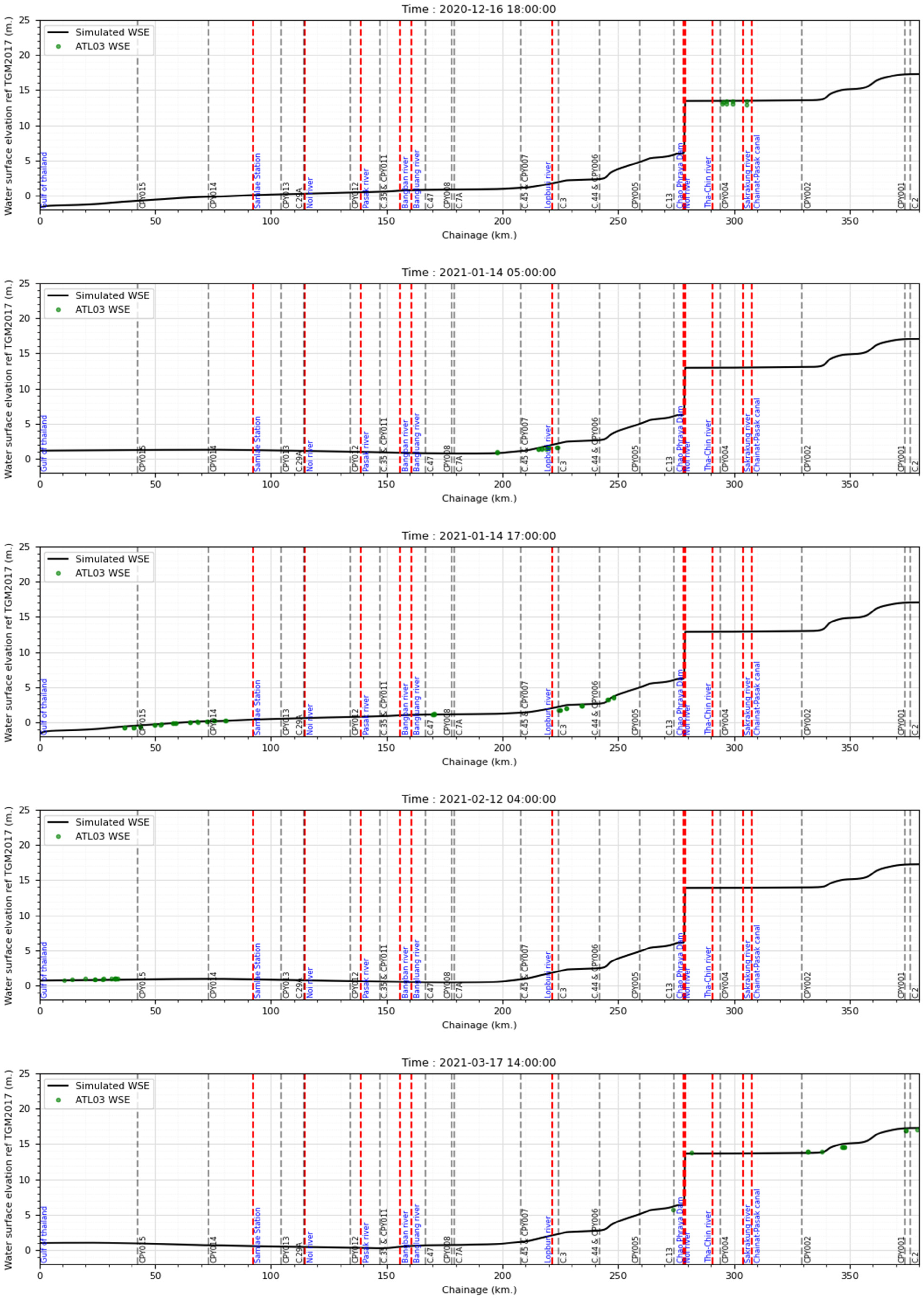
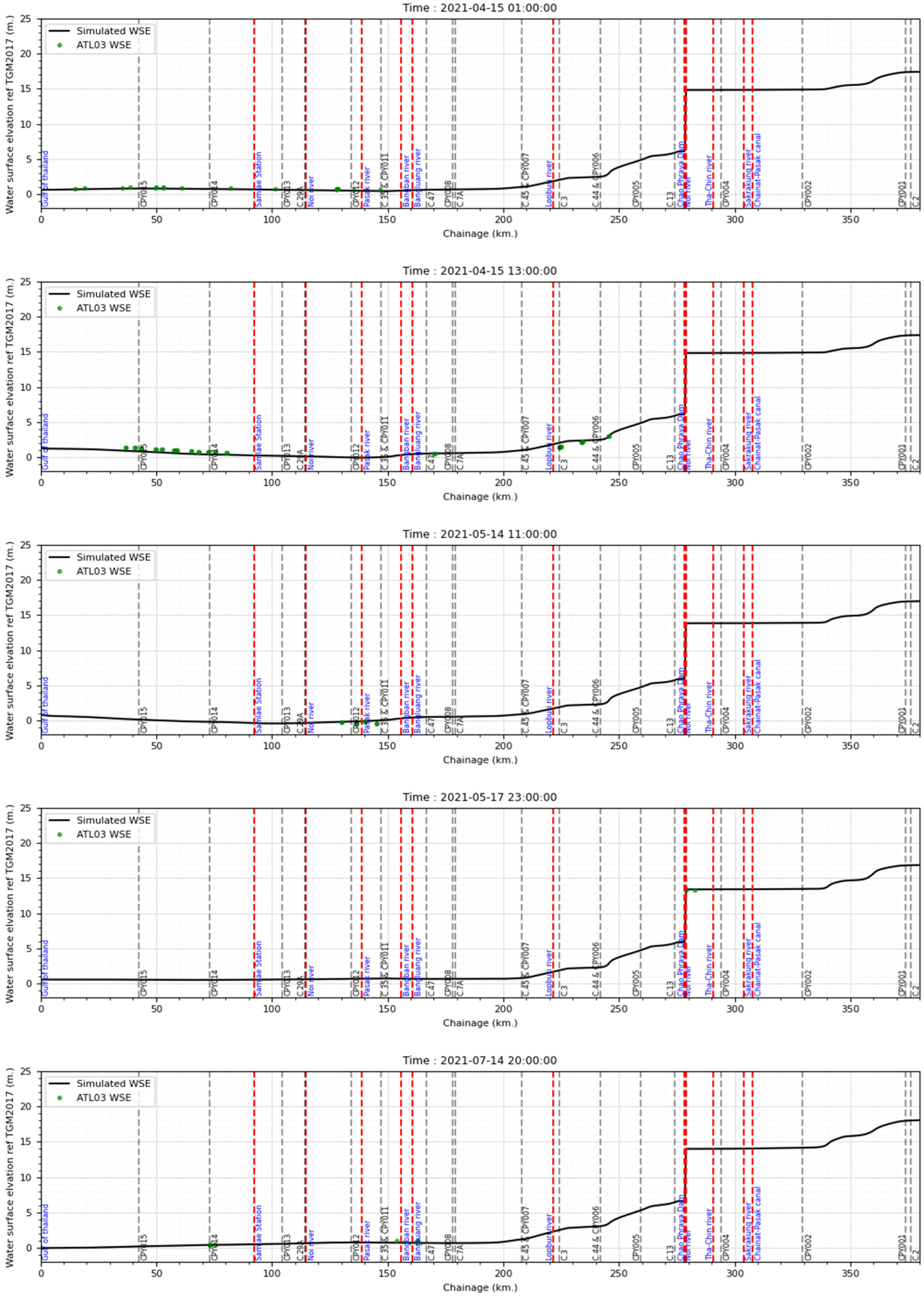
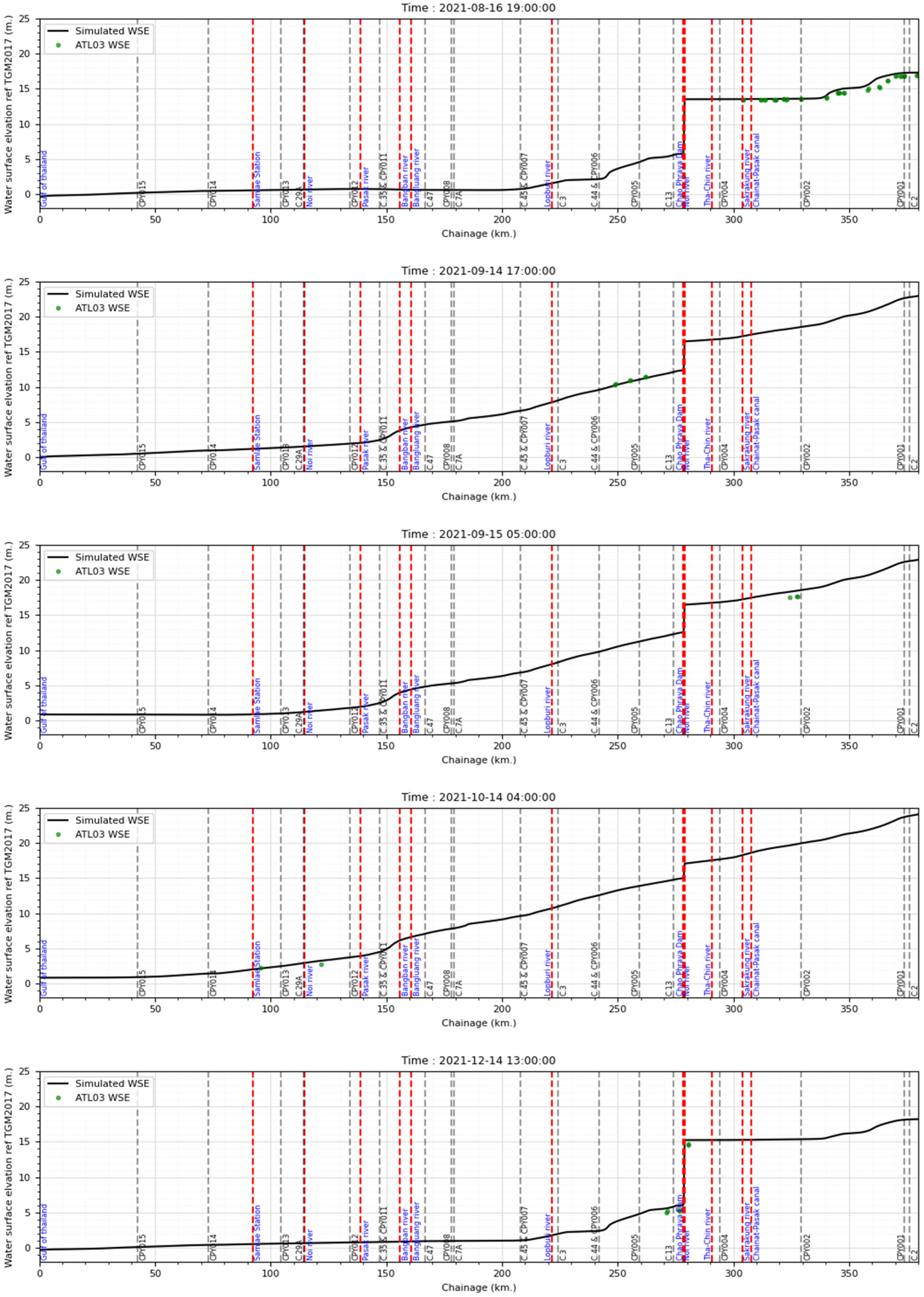
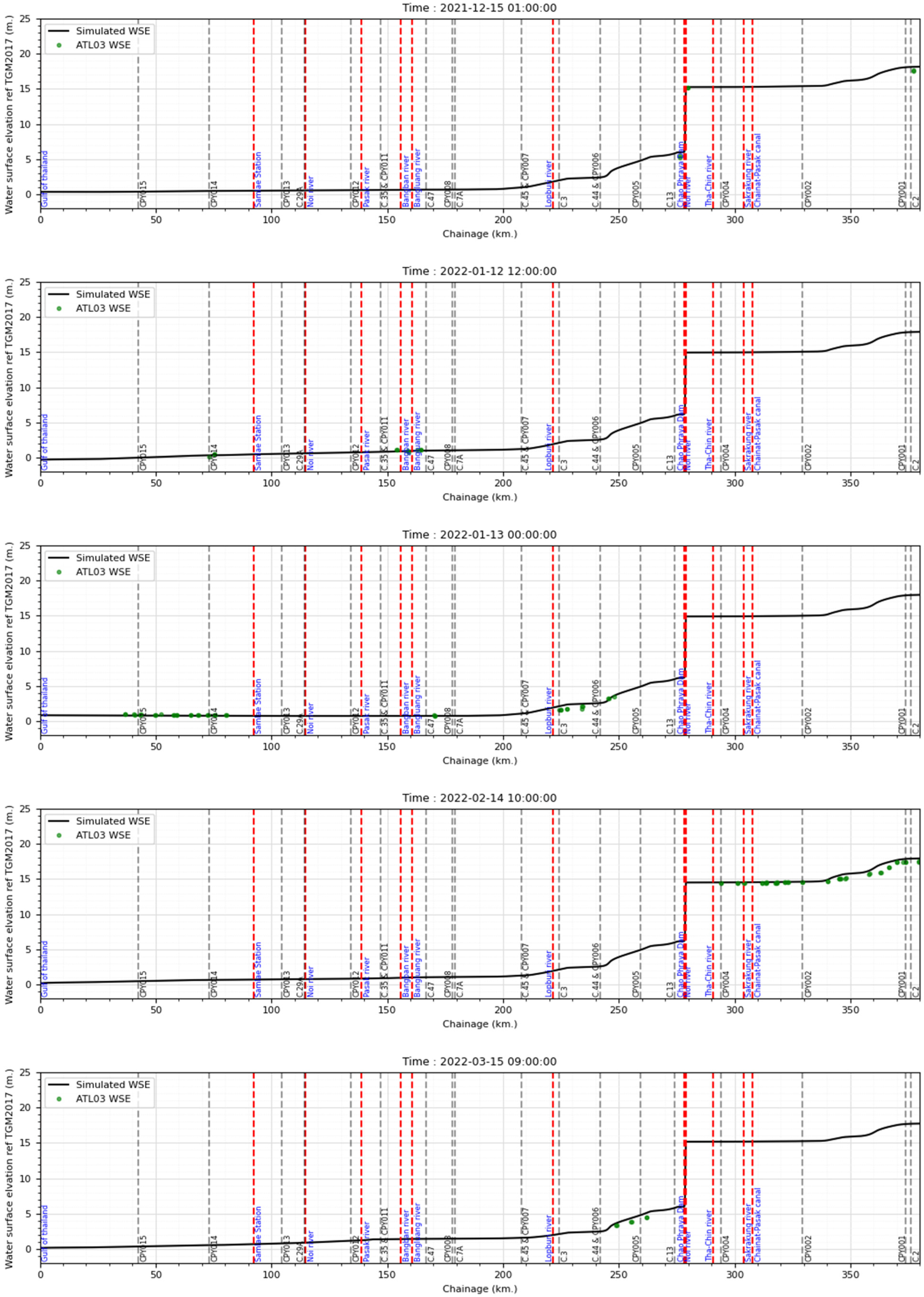
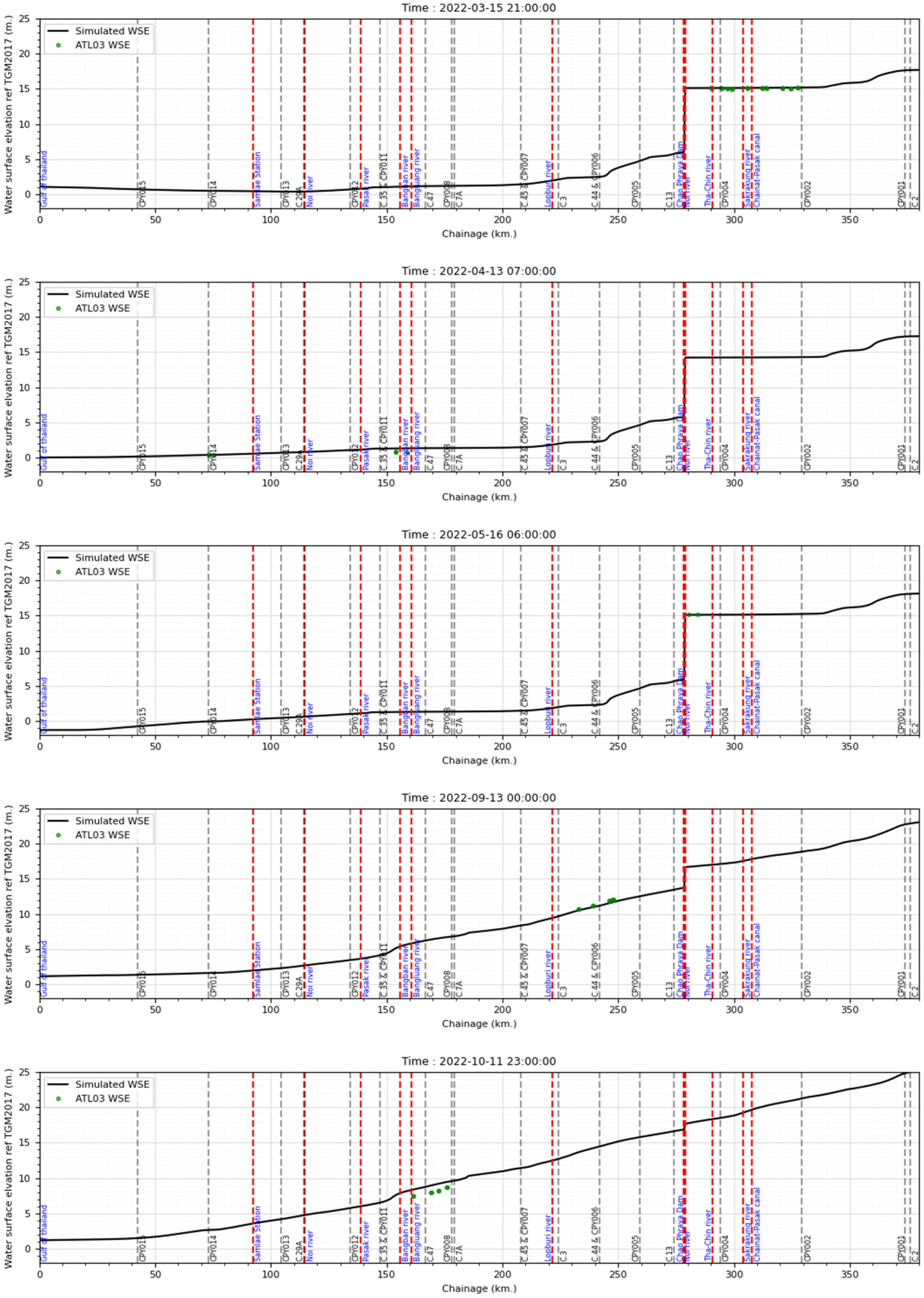
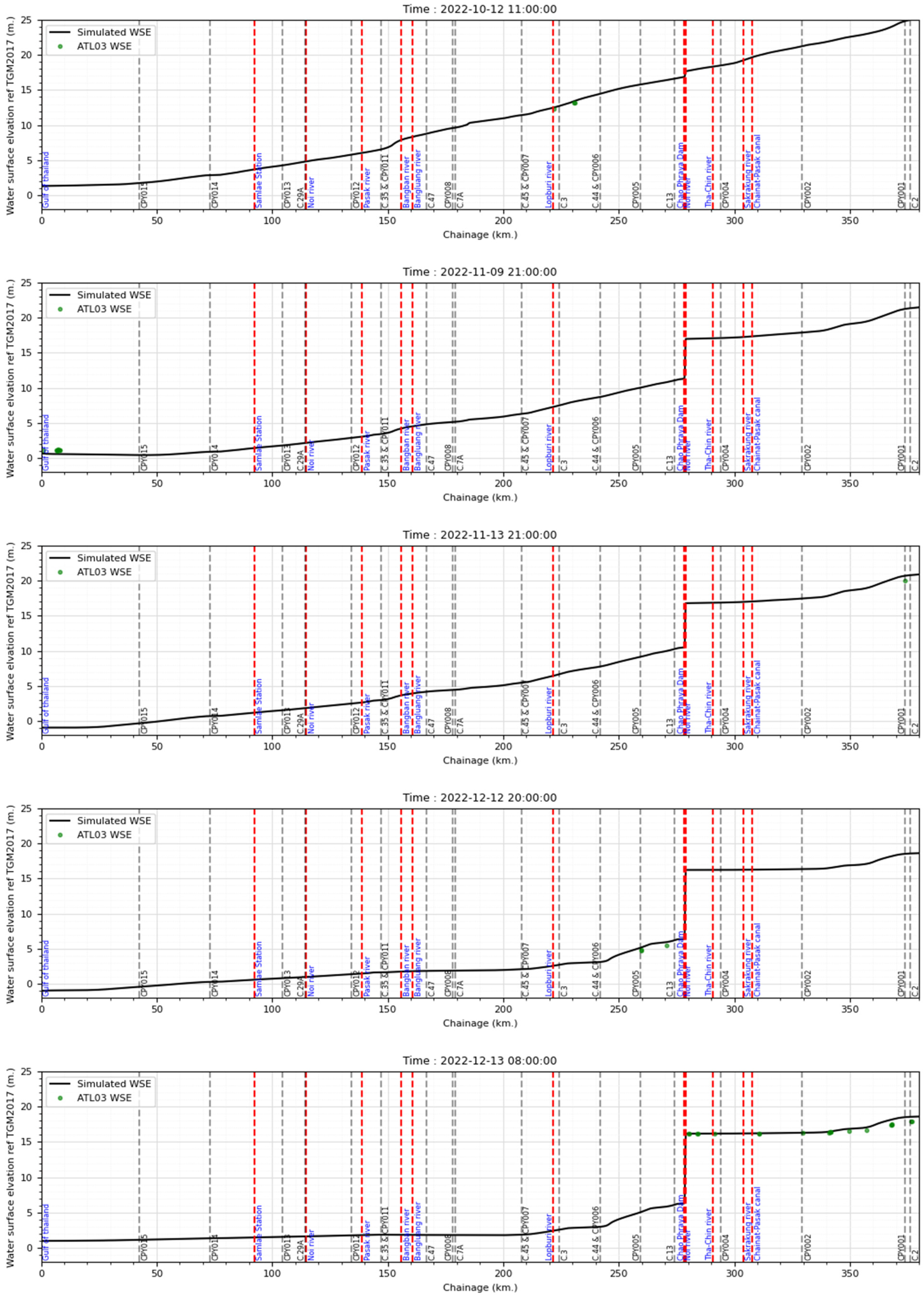
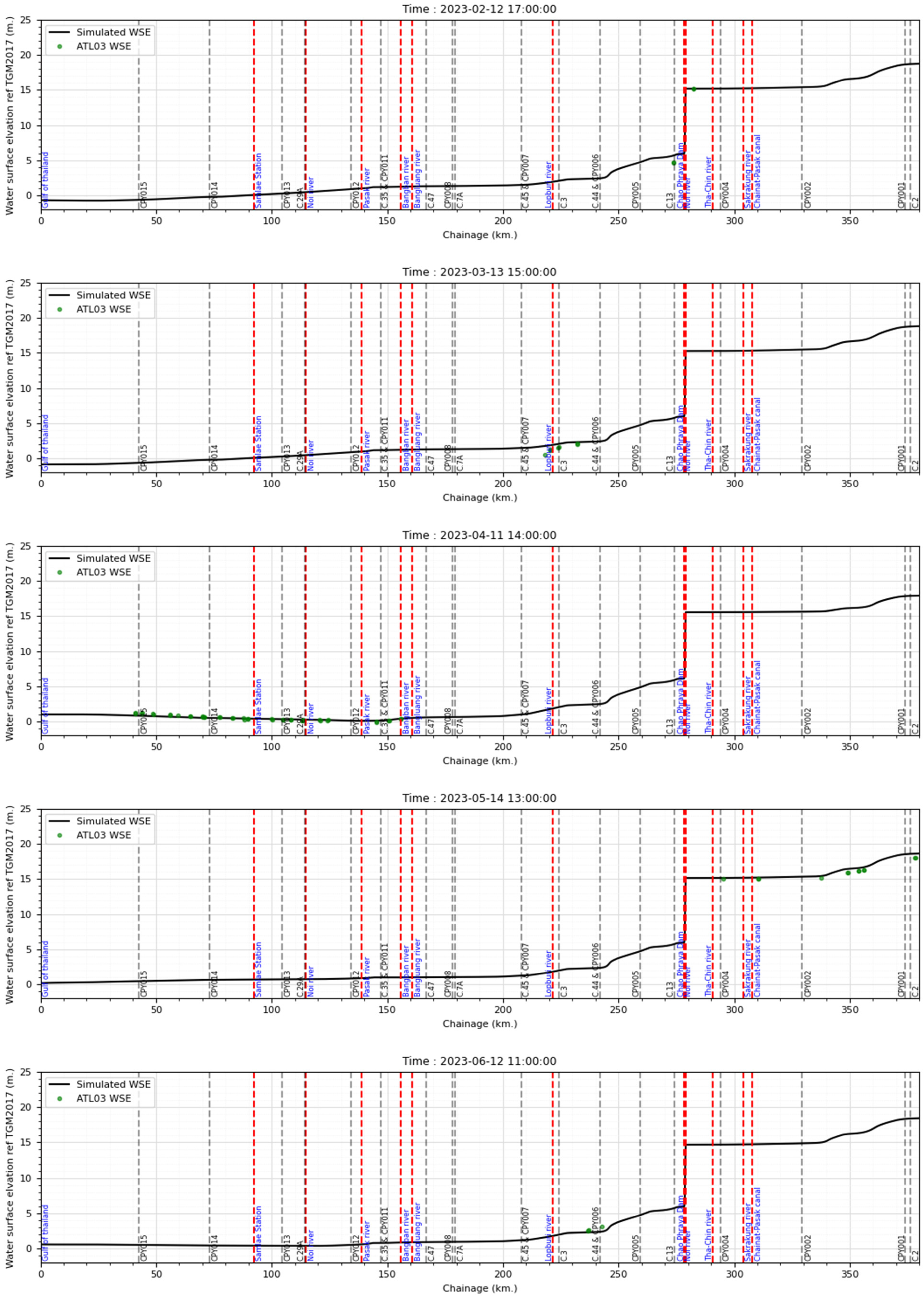
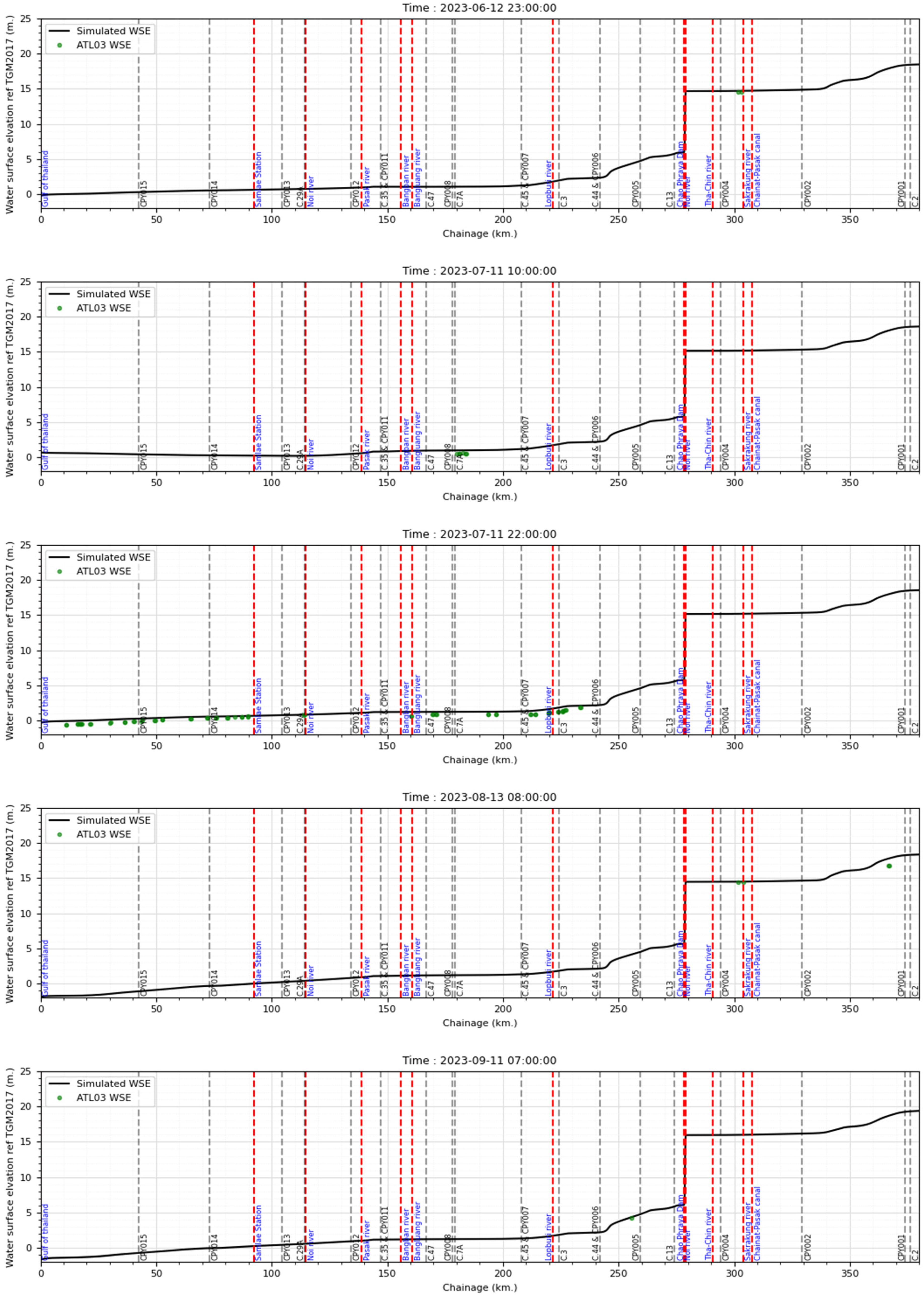
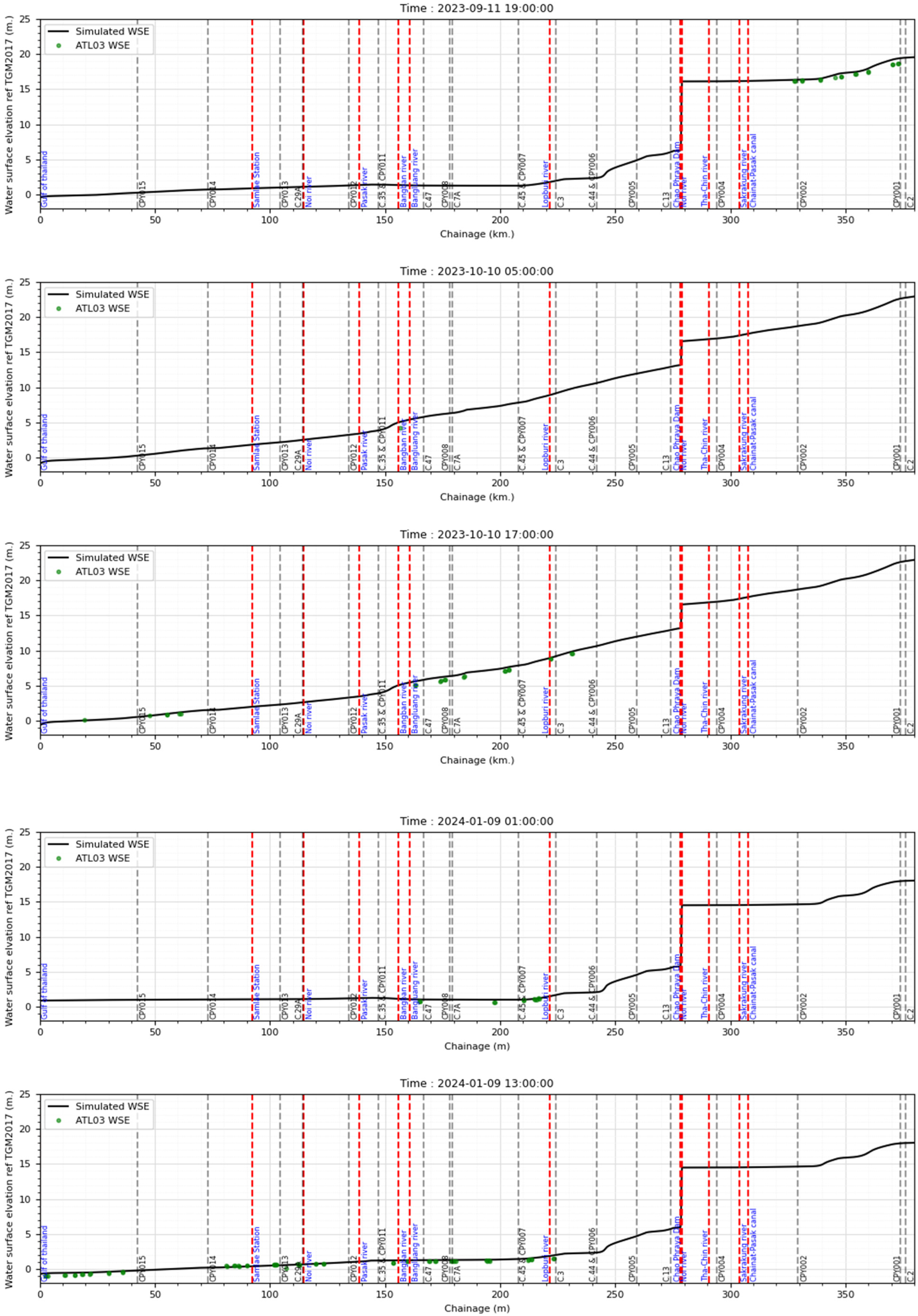
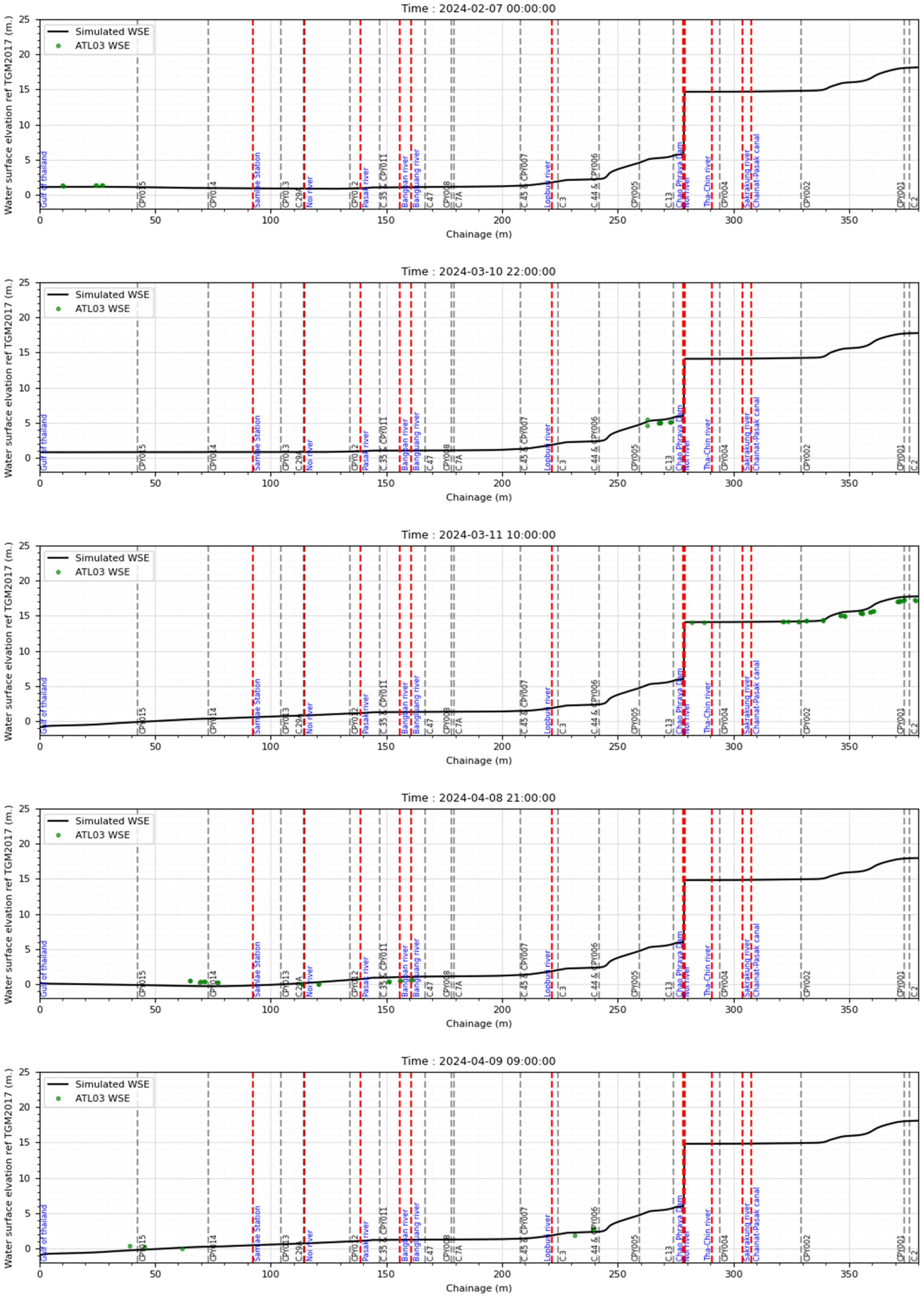
Appendix B. SWOT Data Processing
Illustrates the Comparison Between Simulated WSE Derived from the Hydraulic Model and SWOT WSE from the SWOT Satellite at Various Time Intervals
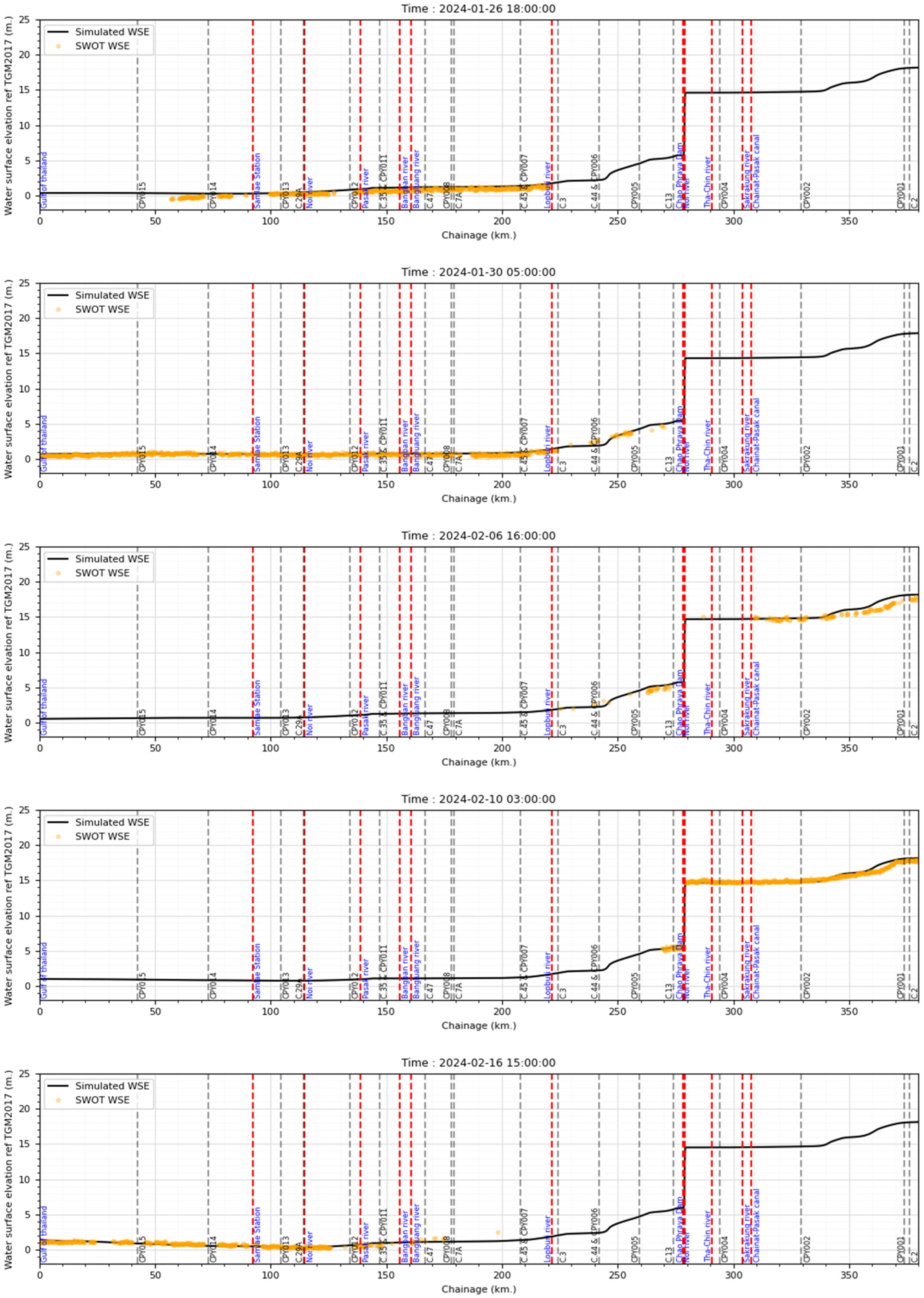
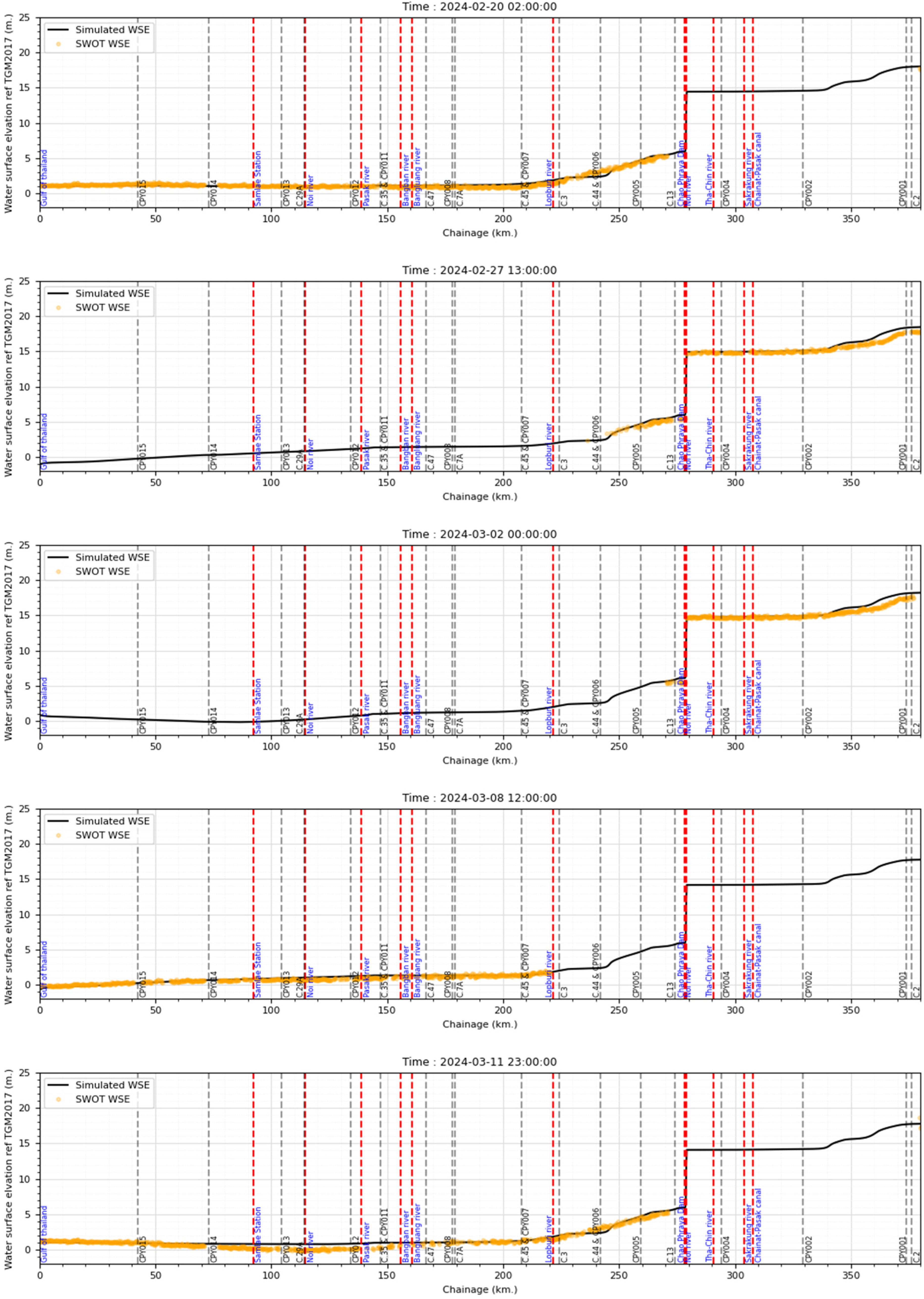

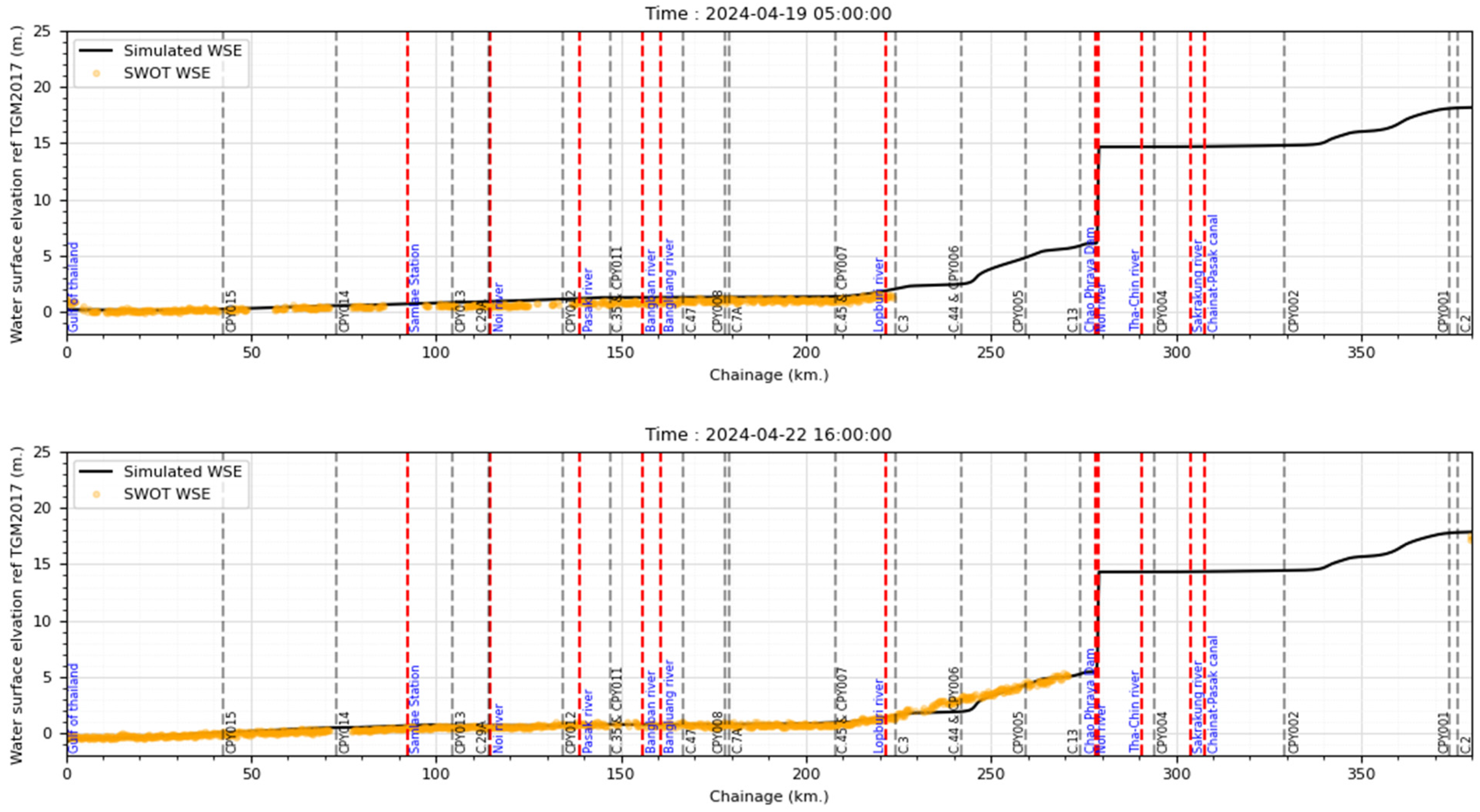
Appendix C. Water Surface Elevation (WSE) Evaluation
Appendix C.1. Simulated—In Situ WSE Comparison
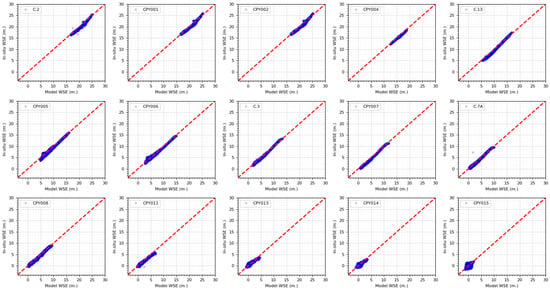
Figure A2.
Comparison of simulated WSE and in situ WSE each in situ station.
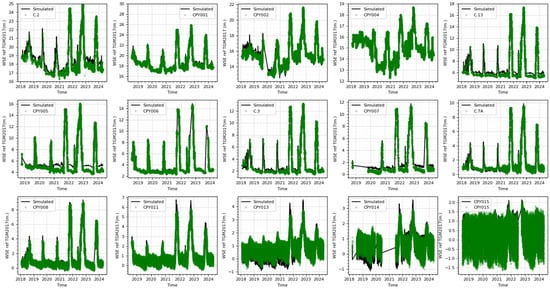
Figure A3.
Comparison of simulated WSE and in situ WSE time series each in situ station.
Appendix C.2. WSE Profile Comparison
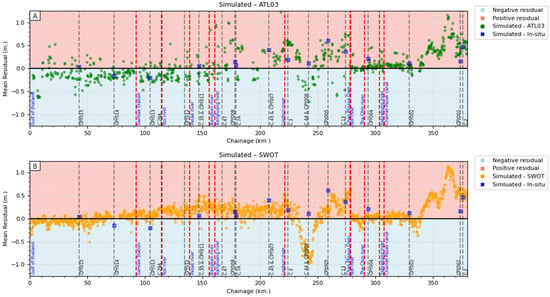
Figure A4.
The mean residual comparison of WSE between pairs: (A) simulated—ATL03 and (B) simulated—SWOT along the CPY river.
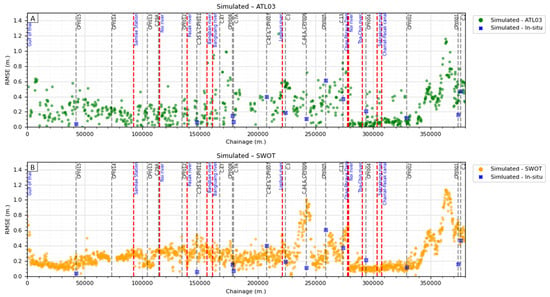
Figure A5.
The RMSE comparison of WSE between pairs: (A) simulated—ATL03 and (B) simulated—SWOT along the CPY river.
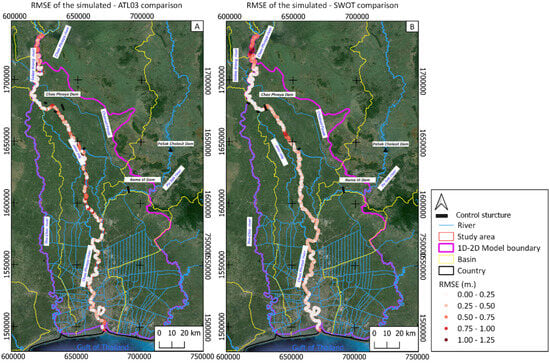
Figure A6.
Overview of the spatial distribution of performance characteristics along CPY river. The distribution of RMSE of WSE between pairs: (A) simulated—ATL03 and (B) simulated—SWOT. All panels are based on the Universal Transverse Mercator (UTM) Zone 47 North coordinate system. © Google Earth.
References
- Gasmelseid, T.M. Handbook of Research on Hydroinformatics: Technologies, Theories and Applications; IGI Global: Hershey, PA, USA, 2010; pp. 1–587. [Google Scholar] [CrossRef]
- Wang, L.; Lian, Y.; Li, Z. Hydraulic Analysis for Strategic Management of Flood Risks along the Illinois River. Environ. Earth Sci. 2019, 78, 80. [Google Scholar] [CrossRef]
- Godyn, I. A Revised Approach to Flood Damage Estimation in Flood Risk. Water 2021, 13, 2713. [Google Scholar] [CrossRef]
- Icyimpaye, G.; Abdelbaki, C.; Mourad, K.A. Hydrological and Hydraulic Model for Flood Forecasting in Rwanda. Model. Earth Syst. Environ. 2022, 8, 1179–1189. [Google Scholar] [CrossRef]
- Arduino, G.; Reggiani, P.; Todini, E. Recent Advances in Flood Forecasting and Flood Risk Assessment. Hydrol. Earth Syst. Sci. 2005, 9, 280–284. [Google Scholar] [CrossRef]
- Charoensuk, T.; Lolupiman, T.; Chantip, S.; Sisomphon, P. Modeling Dike Breaching in The Chao Phraya River Basin Using High Resolution Elevation Data (Lidar). In Proceedings of the 13th International Conference on Hydroscience & Engineering. Advancement of Hydro-Engineering for Sustainable Development, Chongqing, China, 18–22 June 2018. [Google Scholar]
- Gu, X.W.; Yang, W.L.; Dong, G.T.; Dang, S.Z. Application of One-Dimensional Hydraulic Model for Flood Simulation in Yellow River Delta. Adv. Mater. Res. 2014, 955–959, 2969–2972. [Google Scholar] [CrossRef]
- Kidson, R.L.; Richards, K.S.; Carling, P.A. Hydraulic Model Calibration for Extreme Floods in Bedrock-Confined Channels: Case Study from Northern Thailand. Hydrol. Process. 2006, 20, 329–344. [Google Scholar] [CrossRef]
- Domeneghetti, A.; Tarpanelli, A.; Brocca, L.; Barbetta, S.; Moramarco, T.; Castellarin, A.; Brath, A. The Use of Remote Sensing-Derived Water Surface Data for Hydraulic Model Calibration. Remote Sens. Environ. 2014, 149, 130–141. [Google Scholar] [CrossRef]
- Lollino, G.; Arattano, M.; Rinaldi, M.; Giustolisi, O.; Marechal, J.C.; Grant, G.E. Engineering Geology for Society and Territory—Volume 3: River Basins, Reservoir Sedimentation and Water Resources; Springer: Berlin/Heidelberg, Germany, 2015; Volume 3, pp. 1–657. [Google Scholar] [CrossRef]
- Kittel, C.M.M.; Hatchard, S.; Neal, J.C.; Nielsen, K.; Bates, P.D.; Bauer-Gottwein, P. Hydraulic Model Calibration Using CryoSat-2 Observations in the Zambezi Catchment. Water Resour. Res. 2021, 57, e2020WR029261. [Google Scholar] [CrossRef]
- Domeneghetti, A.; Molari, G.; Tourian, M.J.; Tarpanelli, A.; Behnia, S.; Moramarco, T.; Sneeuw, N.; Brath, A. Testing the Use of Single- and Multi-Mission Satellite Altimetry for the Calibration of Hydraulic Models. Adv. Water Resour. 2021, 151, 103887. [Google Scholar] [CrossRef]
- Neumann, T.A.; Martino, A.J.; Markus, T.; Bae, S.; Bock, M.R.; Brenner, A.C.; Brunt, K.M.; Cavanaugh, J.; Fernandes, S.T.; Hancock, D.W.; et al. The Ice, Cloud, and Land Elevation Satellite—2 Mission: A Global Geolocated Photon Product Derived from the Aadvanced Ttopographic Llaser Aaltimeter Ssystem. Remote Sens. Environ. 2019, 233, 111325. [Google Scholar] [CrossRef] [PubMed]
- Dandabathula, G.; Srinivasa Rao, S. Validation of ICESat-2 Surface Water Level Product ATL13 with Near Real Time Gauge Data. Hydrology 2020, 8, 19. [Google Scholar] [CrossRef]
- Yuan, C.; Gong, P.; Bai, Y. Performance Assessment of ICESat-2 Laser Altimeter Data for Water-Level Measurement over Lakes and Reservoirs in China. Remote Sensing 2020, 12, 770. [Google Scholar] [CrossRef]
- Guo, X.; Jin, S.; Zhang, Z. Evaluation of Water Level Estimation in the Upper Yangtze River from ICESat-2 Data. Prog. Electromagn. Res. Symp. 2021, 2021, 2260–2264. [Google Scholar] [CrossRef]
- Xie, J.; Li, B.; Jiao, H.; Zhou, Q.; Mei, Y.; Xie, D.; Wu, Y.; Sun, X.; Fu, Y. Water Level Change Monitoring Based on a New Denoising Algorithm Using Data from Landsat and ICESat-2: A Case Study of Miyun Reservoir in Beijing. Remote Sensing 2022, 14, 4344. [Google Scholar] [CrossRef]
- Zhou, H.; Liu, S.; Mo, X.; Hu, S.; Zhang, L.; Ma, J.; Bandini, F.; Grosen, H.; Bauer-Gottwein, P. Calibrating a Hydrodynamic Model Using Water Surface Elevation Determined from ICESat-2 Derived Cross-Section and Sentinel-2 Retrieved Sub-Pixel River Width. Remote Sens. Environ. 2023, 298, 113796. [Google Scholar] [CrossRef]
- Scherer, D.; Schwatke, C.; Dettmering, D.; Seitz, F. ICESat-2 Based River Surface Slope and Its Impact on Water Level Time Series From Satellite Altimetry. Water Resour. Res. 2022, 58, e2022WR032842. [Google Scholar] [CrossRef]
- Narin, O.G.; Abdikan, S. Multi-Temporal Analysis of Inland Water Level Change Using ICESat-2 ATL-13 Data in Lakes and Dams. Environ. Sci. Pollut. Res. 2023, 30, 15364–15376. [Google Scholar] [CrossRef] [PubMed]
- Chen, Y.; Liu, Q.; Ticehurst, C.; Sarker, C.; Karim, F.; Penton, D.; Sengupta, A. Refining ICESAT-2 ATL13 Altimetry Data for Improving Water Surface Elevation Accuracy on Rivers. Remote Sens. 2024, 16, 1706. [Google Scholar] [CrossRef]
- Fjørtoft, R.; Gaudin, J.M.; Pourthié, N.; Lalaurie, J.C.; Mallet, A.; Nouvel, J.F.; Martinot-Lagarde, J.; Oriot, H.; Borderies, P.; Ruiz, C.; et al. KaRIn on SWOT: Characteristics of near-Nadir Ka-Band Interferometric SAR Imagery. IEEE Trans. Geosci. Remote Sens. 2014, 52, 2172–2185. [Google Scholar] [CrossRef]
- Durand, M.; Neal, J.; Rodríguez, E.; Andreadis, K.M.; Smith, L.C.; Yoon, Y. Estimating Reach-Averaged Discharge for the River Severn from Measurements of River Water Surface Elevation and Slope. J. Hydrol. 2014, 511, 92–104. [Google Scholar] [CrossRef]
- Cha, Y.; Park, S.S.; Kim, K.; Byeon, M.; Stow, C.A. Reply to comment by J. S. Selker et al. on “Capabilities and limitations of tracing spatial temperature patterns by fiber-optic distributed temperature sensing”. Water Resour. Res. 2014, 50, 5375–5377. [Google Scholar] [CrossRef]
- Langhorst, T.; Pavelsky, T.M.; Frasson, R.P.d.M.; Wei, R.; Domeneghetti, A.; Altenau, E.H.; Durand, M.T.; Minear, J.T.; Wegmann, K.W.; Fuller, M.R. Anticipated Improvements to River Surface Elevation Profiles from the Surface Water and Ocean Topography Mission. Front. Earth Sci. 2019, 7, 102. [Google Scholar] [CrossRef]
- Chevalier, L.; Desroches, D.; Laignel, B.; Fjortoft, R.; Turki, I.; Allain, D.; Lyard, F.; Blumstein, D.; Salameh, E. High-Resolution SWOT Simulations of the Macrotidal Seine Estuary in Different Hydrodynamic Conditions. IEEE Geosci. Remote Sens. Lett. 2019, 16, 5–9. [Google Scholar] [CrossRef]
- Sisomphon, P.; Boonya-aroonnet, S.; Chonwattana, S. Towards the development of a decision support system for flood management in chao phraya river basin, thailand. In Proceedings of the International Conference on Flood Resilience, Experiences in Asia and Europe, Exeter, UK, 5–7 September 2013. [Google Scholar]
- Charoensuk, T.; Luchner, J.; Balbarini, N.; Sisomphon, P.; Bauer-Gottwein, P. Enhancing the Capabilities of the Chao Phraya Forecasting System through the Integration of Pre-Processed Numerical Weather Forecasts. J. Hydrol. Reg. Stud. 2024, 52, 101737. [Google Scholar] [CrossRef]
- DHI Water and Environment. MIKE 11 Reference Manual; Scribd: San Francisco, CA, USA, 2021; ISBN 1672-1683. [Google Scholar]
- DHI MIKE 21 FLOW MODEL FM, Reference Mannual; Scribd: San Francisco, CA, USA, 2018; Volume 55.
- DHI Water and Environment. MIKE FLOOD Reference Manual; Scribd: San Francisco, CA, USA, 2019; Volume 37. [Google Scholar]
- Markus, T.; Neumann, T.; Martino, A.; Abdalati, W.; Brunt, K.; Csatho, B.; Farrell, S.; Fricker, H.; Gardner, A.; Harding, D.; et al. The Ice, Cloud, and Land Elevation Satellite-2 (ICESat-2): Science Requirements, Concept, and Implementation. Remote Sens. Environ. 2017, 190, 260–273. [Google Scholar] [CrossRef]
- Tom Neumann; Anita Brenner; David Hancock; John Robbins; Jack Saba; Kaitlin Harbeck; Aimée Gibbons; Jeffrey Lee; Scott Luthcke; Tim Rebold Algorithm Theoretical Basis Document (ATBD) for Global Geolocated Photons ATL03. Remote Sens. Environ. 2021, 2, 7–208.
- Jasinski, M.; Gsfc, N.; Stoll, J.; Hancock, D.; Robbins, J.; Nattala, J.; Morison, J.; Jones, B.; Ondrusek, M.; Parrish, C.; et al. ICESat-2 Algorithm Theoretical Basis Document (ATBD) for Along Track Inland Surface Water Data, ATL13, Version 6; Goddard Space Flight Center Greenbelt, NASA: Greenbelt, MD, USA, 2023; Volume 2. [CrossRef]
- Biancamaria, S.; Lettenmaier, D.P.; Pavelsky, T.M. The SWOT Mission and Its Capabilities for Land Hydrology. Surv. Geophys. 2016, 37, 307–337. [Google Scholar] [CrossRef]
- Desai, S.; Chen, C.; Picot, N.; Fjørtoft, R.; Bohe, A. SWOT Project Release Note for Sample Data Products; NASA: Greenbelt, MD, USA, 2021; Volume 16.
- Surface Water Ocean Topography (SWOT). 2024. SWOT Level 2 River Single-Pass Vector Data Product, Version C. Ver. C. PO.DAAC, CA, USA. Dataset. Available online: https://doi.org/10.5067/SWOT-RIVERSP-2.0 (accessed on 5 May 2024).
- JPLD-56413 Revision B. SWOT Product Description Document: Level 2 KaRIn High Rate River Single Pass Vector (L2_HR_RiverSP) Data Product. In Jet Propulsion Laboratory Internal Document; NASA SWOT: Hawthorne, CA, USA, 2023.
- Tottrup, C.; Druce, D.; Meyer, R.P.; Christensen, M.; Riffler, M.; Dulleck, B.; Rastner, P.; Jupova, K.; Sokoup, T.; Haag, A.; et al. Surface Water Dynamics from Space: A Round Robin Intercomparison of Using Optical and SAR High-Resolution Satellite Observations for Regional Surface Water Detection. Remote Sens. 2022, 14, 2410. [Google Scholar] [CrossRef]
- Dumrongchai, P.; Srimanee, C.; Duangdee, N.; Bairaksa, J. The Determination of Thailand Geoid Model 2017 (TGM2017) from Airborne and Terrestrial Gravimetry. Terr. Atmos. Ocean. Sci. 2021, 32, 859–874. [Google Scholar] [CrossRef]
- Lian, W.; Zhang, G.; Cui, H.; Chen, Z.; Wei, S.; Zhu, C.; Xie, Z. Extraction of High-Accuracy Control Points Using ICESat-2 ATL03 in Urban Areas. Int. J. Appl. Earth Obs. Geoinf. 2022, 115, 103116. [Google Scholar] [CrossRef]
- Smith, B.; Fricker, H.A.; Holschuh, N.; Gardner, A.S.; Adusumilli, S.; Brunt, K.M.; Csatho, B.; Harbeck, K.; Huth, A.; Neumann, T.; et al. Land Ice Height-Retrieval Algorithm for NASA’s ICESat-2 Photon-Counting Laser Altimeter. Remote Sens. Environ. 2019, 233, 111352. [Google Scholar] [CrossRef]
- Pearson, R.K.; Neuvo, Y.; Astola, J.; Gabbouj, M. Generalized Hampel Filters. Eurasip J. Adv. Signal Process. 2016, 2016, 87. [Google Scholar] [CrossRef]
- Coppo Frias, M.; Liu, S.; Mo, X.; Nielsen, K.; Ranndal, H.; Jiang, L.; Ma, J.; Bauer-Gottwein, P. River Hydraulic Modeling with ICESat-2 Land and Water Surface Elevation. Hydrol. Earth Syst. Sci. 2023, 27, 1011–1032. [Google Scholar] [CrossRef]
- Pavlis, N.K.; Holmes, S.A.; Kenyon, S.C.; Factor, J.K. The Development and Evaluation of the Earth Gravitational Model 2008 (EGM2008). J. Geophys. Res. Solid Earth 2012, 117, 1–12. [Google Scholar] [CrossRef]
- Cleveland, W.S. Robust Locally Weighted Regression and Smoothing Scatterplots. J. Am. Stat. Assoc. 1979, 74, 829–836. [Google Scholar] [CrossRef]
- Xu, N.; Zheng, H.; Ma, Y.; Yang, J.; Liu, X.; Wang, X. Global Estimation and Assessment of Monthly Lake/Reservoir Water Level Changes Using ICESat-2 ATL13 Products. Remote Sens. 2021, 13, 2744. [Google Scholar] [CrossRef]
- Musaeus, A.F.; Kittel, C.M.M.; Luchner, J.; Frias, M.C.; Bauer-Gottwein, P. Hydraulic River Models From ICESat-2 Elevation and Water Surface Slope. Water Resour. Res. 2024, 60, e2023WR036428. [Google Scholar] [CrossRef]
- Yamazaki, D.; Ikeshima, D.; Tawatari, R.; Yamaguchi, T.; O’Loughlin, F.; Neal, J.C.; Sampson, C.C.; Kanae, S.; Bates, P.D. A High-Accuracy Map of Global Terrain Elevations. Geophys. Res. Lett. 2017, 44, 5844–5853. [Google Scholar] [CrossRef]
- Li, Y.; Gao, H.; Jasinski, M.F.; Zhang, S.; Stoll, J.D. Deriving High-Resolution Reservoir Bathymetry from ICESat-2 Prototype Photon-Counting Lidar and Landsat Imagery. IEEE Trans. Geosci. Remote Sens. 2019, 57, 7883–7893. [Google Scholar] [CrossRef]
- Bergeron, J.; Siles, G.; Leconte, R.; Trudel, M.; Desroches, D.; Peters, D.L. Assessing the Capabilities of the Surface Water and Ocean Topography (SWOT) Mission for Large Lake Water Surface Elevation Monitoring under Different Wind Conditions. Hydrol. Earth Syst. Sci. 2020, 24, 5985–6000. [Google Scholar] [CrossRef]
- Frasson, R.P.d.M.; Schumann, G.J.P.; Kettner, A.J.; Brakenridge, G.R.; Krajewski, W.F. Will the Surface Water and Ocean Topography (SWOT) Satellite Mission Observe Floods? Geophys. Res. Lett. 2019, 46, 10435–10445. [Google Scholar] [CrossRef]
- Domeneghetti, A.; Schumann, G.J.P.; Frasson, R.P.M.; Wei, R.; Pavelsky, T.M.; Castellarin, A.; Brath, A.; Durand, M.T. Characterizing Water Surface Elevation under Different Flow Conditions for the Upcoming SWOT Mission. J. Hydrol. 2018, 561, 848–861. [Google Scholar] [CrossRef]
- Frasson, R.P.d.M.; Pavelsky, T.M.; Fonstad, M.A.; Durand, M.T.; Allen, G.H.; Schumann, G.; Lion, C.; Beighley, R.E.; Yang, X. Global Relationships Between River Width, Slope, Catchment Area, Meander Wavelength, Sinuosity, and Discharge. Geophys. Res. Lett. 2019, 46, 3252–3262. [Google Scholar] [CrossRef]
- JPL D-105505 “Algorithm Theoretical Basis Document (ATBD) for Level 2 KaRIn High Rate River Single Pass Science Algorithm Software”. In Jet Propulsion Laboratory Internal Document 2023; NASA SWOT: Hawthorne, CA, USA, 2023; pp. 1–54.
- Andreadis, K.M.; Clark, E.A.; Lettenmaier, D.P.; Alsdorf, D.E. Prospects for River Discharge and Depth Estimation through Assimilation of Swath-Altimetry into a Raster-Based Hydrodynamics Model. Geophys. Res. Lett. 2007, 34, 1–5. [Google Scholar] [CrossRef]
- Biancamaria, S.; Durand, M.; Andreadis, K.M.; Bates, P.D.; Boone, A.; Mognard, N.M.; Rodríguez, E.; Alsdorf, D.E.; Lettenmaier, D.P.; Clark, E.A. Assimilation of Virtual Wide Swath Altimetry to Improve Arctic River Modeling. Remote Sens. Environ. 2011, 115, 373–381. [Google Scholar] [CrossRef]
- Munier, S.; Polebistki, A.; Brown, C.; Belaud, G.; Lettenmaier, D.P. SWOT Data Assimilation for Operational Reservoir Management on the Upper Niger River Basin. Water Resour. Res. 2015, 51, 554–575. [Google Scholar] [CrossRef]
- Elmer, N.J.; Hain, C.; Hossain, F.; Desroches, D.; Pottier, C. Generating Proxy SWOT Water Surface Elevations Using WRF-Hydro and the CNES SWOT Hydrology Simulator. Water Resour. Res. 2020, 56, e2020WR027464. [Google Scholar] [CrossRef]
- Abam, T.K.S.; Omuso, W.O. On River Cross-Sectional Change in the Niger Delta. Geomorphology 2000, 34, 111–126. [Google Scholar] [CrossRef]
- Ogawa, Y.; Fujita, Y.; Shuto, N. Change in the Cross-Sectional Area and Topography at River Mouth. Coast. Eng. Jpn. 1984, 27, 233–247. [Google Scholar] [CrossRef]
- Chettanawanit, K.; Charoensuk, T.; Luangdilok, N.; Thanathanphon, W.; Mooktaree, A.; Lolupiman, T.; Kyaw, K.K.; Sisomphon, P. Simulation of Water Losses for the 1D Salinity Forecasting Model in Chao Phraya River. Eng. Access 2022, 8, 161–166. [Google Scholar] [CrossRef]
- JICA. Data Collection Survey on the Outer Ring Road Diversion Channel in the Comprehensive Flood Management Plan for the Chao Phraya River Basin in the Kingdom of Thailand; JICA: Tokyo, Japan, 2018.
- Visessri, S.; Ekkawatpanit, C. Flood Management in the Context of Climate and Land-Use Changes and Adaptation within the Chao Phraya River Basin. J. Disaster Res. 2020, 15, 579–587. [Google Scholar] [CrossRef]
- Mohd Anuar, M.A.; Mohd Adnan, M.S.; Lim, F.H. Uncertainty in River Hydraulic Modelling: A Review for Fundamental Understanding; Springer: Singapore, 2022; Volume 214, ISBN 9789811679193. [Google Scholar]
- Bauer-Gottwein, P.; Zakharova, E.; Coppo Frías, M.; Ranndal, H.; Nielsen, K.; Christoffersen, L.; Liu, J.; Jiang, L. A Hydraulic Model of the Amur River Informed by ICESat-2 Elevation. Hydrol. Sci. J. 2023, 68, 2027–2041. [Google Scholar] [CrossRef]
- Chow, V. Te Applied Hydrology. J. Hydrol. 1968, 6, 224–225. [Google Scholar] [CrossRef]
- Hadiani, M.O.; Gholami, V.; Azar, Z. Investigation on the Effect of the Season in Determination of Manning Roughness Coefficient in Predicting Flood Hydraulic Behavior (Case Study: Haraz River). J. Environ. Stud. 2009, 35, 11–18. [Google Scholar]
- de Moraes Frasson, R.P. Chapter 5—Using the Surface Water and Ocean Topography Mission Data to Estimate River Bathymetry and Channel Roughness. In Earth Observation, Earth Observation for Flood Applications; Elsevier Ltd.: Amsterdam, The Netherlands, 2021; pp. 105–128. ISBN 9780128194126. [Google Scholar]
Disclaimer/Publisher’s Note: The statements, opinions and data contained in all publications are solely those of the individual author(s) and contributor(s) and not of MDPI and/or the editor(s). MDPI and/or the editor(s) disclaim responsibility for any injury to people or property resulting from any ideas, methods, instructions or products referred to in the content. |
© 2025 by the authors. Licensee MDPI, Basel, Switzerland. This article is an open access article distributed under the terms and conditions of the Creative Commons Attribution (CC BY) license (https://creativecommons.org/licenses/by/4.0/).